Business Environment: Organisation Types, Objectives, SWOT Analysis
VerifiedAdded on 2024/05/29
|27
|5454
|253
Report
AI Summary
This report provides a comprehensive analysis of the business environment, focusing on different types of organisations (public, private, and voluntary), their purposes, size, and scope. It examines the relationship between organisational functions and their link to business objectives, along with the positive and negative impacts of the macro environment on business operations. The report includes internal and external analyses of specific organisations to identify strengths and weaknesses, and it applies SWOT/TOWS analysis to demonstrate how these factors influence decision-making. The study also explores the interrelationships between organisational functions and their impact on organisational structure, highlighting the importance of effective business strategies for maintaining healthy workplace environments and achieving business goals.
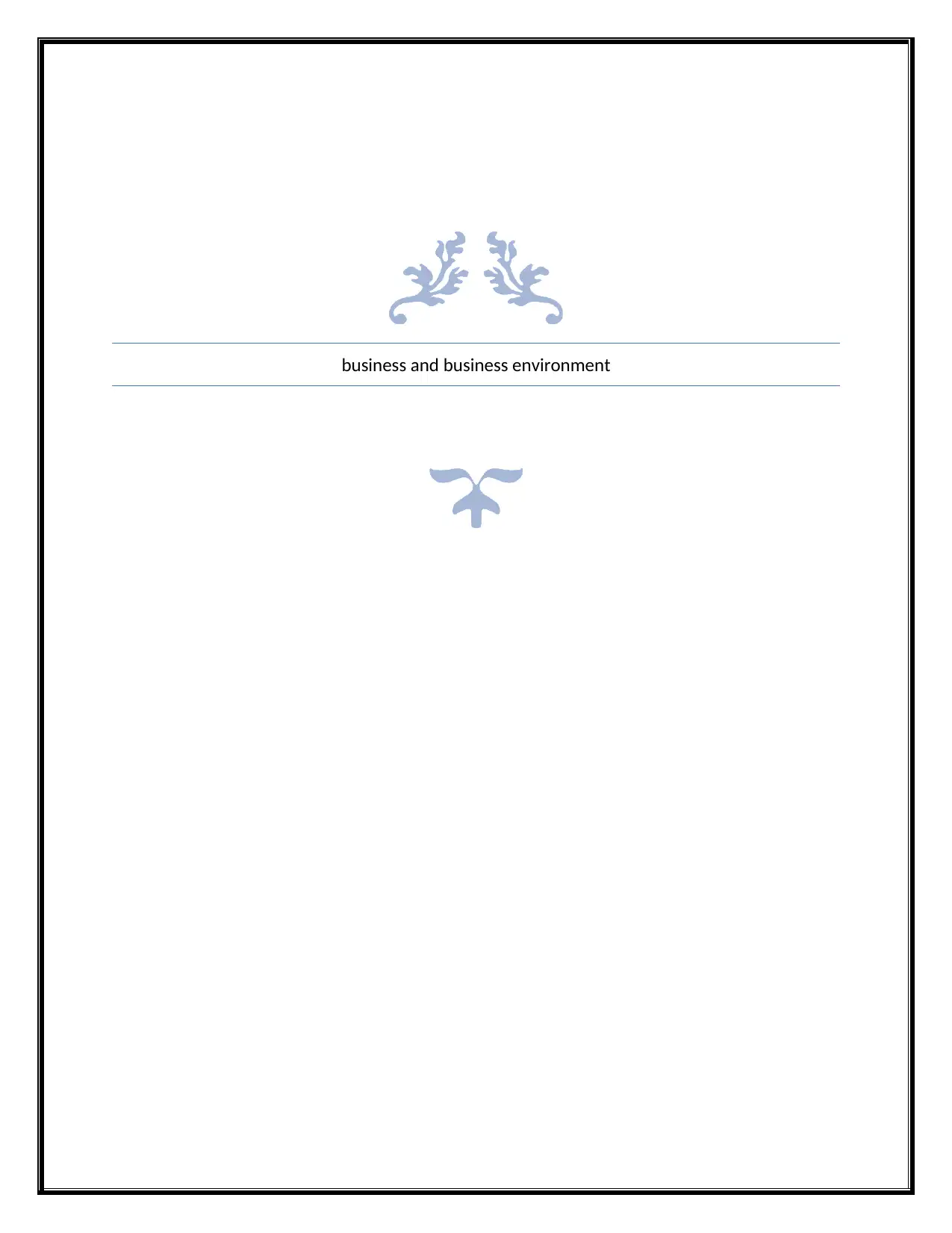
business and business environment
Secure Best Marks with AI Grader
Need help grading? Try our AI Grader for instant feedback on your assignments.
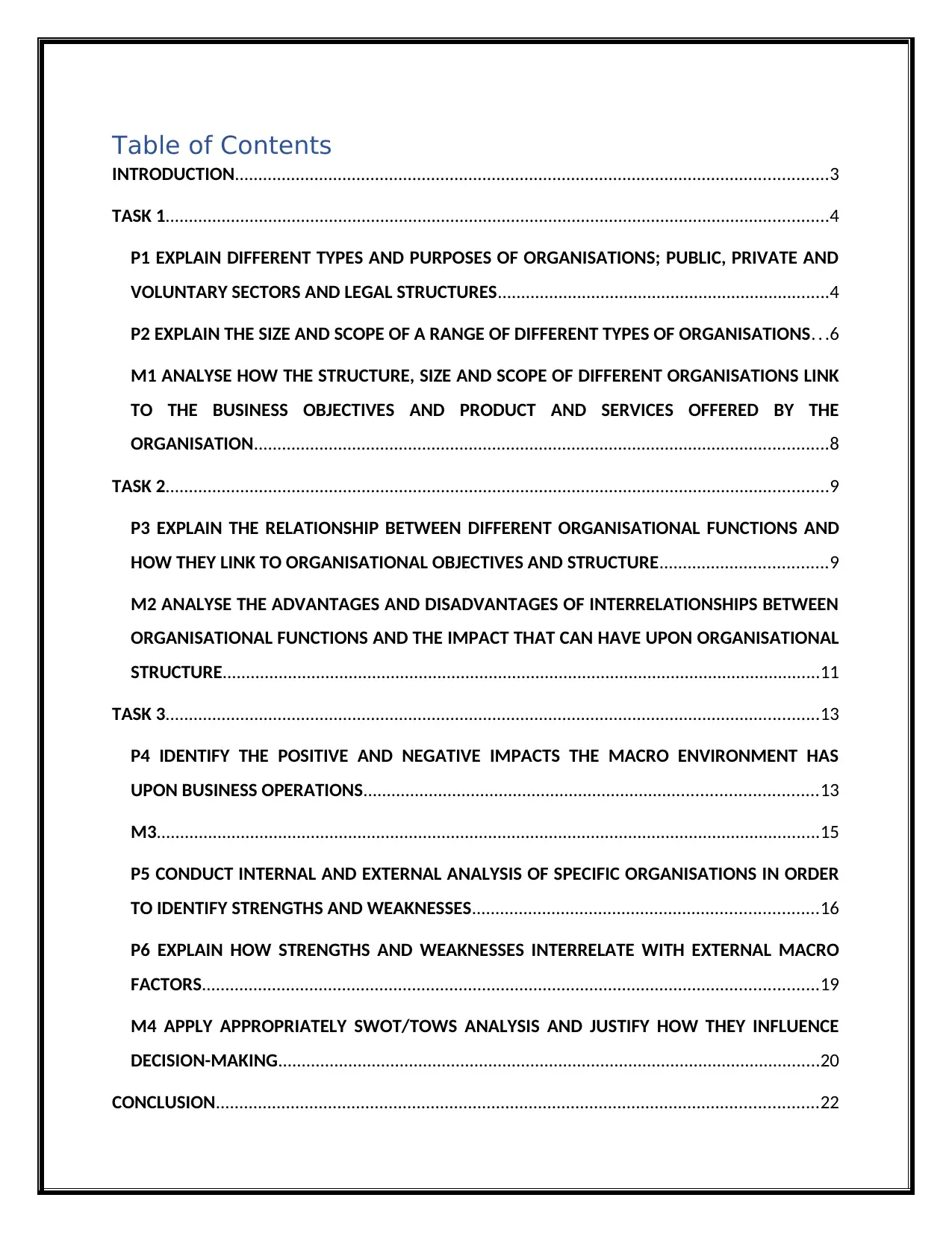
Table of Contents
INTRODUCTION...............................................................................................................................3
TASK 1..............................................................................................................................................4
P1 EXPLAIN DIFFERENT TYPES AND PURPOSES OF ORGANISATIONS; PUBLIC, PRIVATE AND
VOLUNTARY SECTORS AND LEGAL STRUCTURES.......................................................................4
P2 EXPLAIN THE SIZE AND SCOPE OF A RANGE OF DIFFERENT TYPES OF ORGANISATIONS. . .6
M1 ANALYSE HOW THE STRUCTURE, SIZE AND SCOPE OF DIFFERENT ORGANISATIONS LINK
TO THE BUSINESS OBJECTIVES AND PRODUCT AND SERVICES OFFERED BY THE
ORGANISATION...........................................................................................................................8
TASK 2..............................................................................................................................................9
P3 EXPLAIN THE RELATIONSHIP BETWEEN DIFFERENT ORGANISATIONAL FUNCTIONS AND
HOW THEY LINK TO ORGANISATIONAL OBJECTIVES AND STRUCTURE....................................9
M2 ANALYSE THE ADVANTAGES AND DISADVANTAGES OF INTERRELATIONSHIPS BETWEEN
ORGANISATIONAL FUNCTIONS AND THE IMPACT THAT CAN HAVE UPON ORGANISATIONAL
STRUCTURE................................................................................................................................11
TASK 3............................................................................................................................................13
P4 IDENTIFY THE POSITIVE AND NEGATIVE IMPACTS THE MACRO ENVIRONMENT HAS
UPON BUSINESS OPERATIONS.................................................................................................13
M3..............................................................................................................................................15
P5 CONDUCT INTERNAL AND EXTERNAL ANALYSIS OF SPECIFIC ORGANISATIONS IN ORDER
TO IDENTIFY STRENGTHS AND WEAKNESSES..........................................................................16
P6 EXPLAIN HOW STRENGTHS AND WEAKNESSES INTERRELATE WITH EXTERNAL MACRO
FACTORS....................................................................................................................................19
M4 APPLY APPROPRIATELY SWOT/TOWS ANALYSIS AND JUSTIFY HOW THEY INFLUENCE
DECISION-MAKING....................................................................................................................20
CONCLUSION.................................................................................................................................22
INTRODUCTION...............................................................................................................................3
TASK 1..............................................................................................................................................4
P1 EXPLAIN DIFFERENT TYPES AND PURPOSES OF ORGANISATIONS; PUBLIC, PRIVATE AND
VOLUNTARY SECTORS AND LEGAL STRUCTURES.......................................................................4
P2 EXPLAIN THE SIZE AND SCOPE OF A RANGE OF DIFFERENT TYPES OF ORGANISATIONS. . .6
M1 ANALYSE HOW THE STRUCTURE, SIZE AND SCOPE OF DIFFERENT ORGANISATIONS LINK
TO THE BUSINESS OBJECTIVES AND PRODUCT AND SERVICES OFFERED BY THE
ORGANISATION...........................................................................................................................8
TASK 2..............................................................................................................................................9
P3 EXPLAIN THE RELATIONSHIP BETWEEN DIFFERENT ORGANISATIONAL FUNCTIONS AND
HOW THEY LINK TO ORGANISATIONAL OBJECTIVES AND STRUCTURE....................................9
M2 ANALYSE THE ADVANTAGES AND DISADVANTAGES OF INTERRELATIONSHIPS BETWEEN
ORGANISATIONAL FUNCTIONS AND THE IMPACT THAT CAN HAVE UPON ORGANISATIONAL
STRUCTURE................................................................................................................................11
TASK 3............................................................................................................................................13
P4 IDENTIFY THE POSITIVE AND NEGATIVE IMPACTS THE MACRO ENVIRONMENT HAS
UPON BUSINESS OPERATIONS.................................................................................................13
M3..............................................................................................................................................15
P5 CONDUCT INTERNAL AND EXTERNAL ANALYSIS OF SPECIFIC ORGANISATIONS IN ORDER
TO IDENTIFY STRENGTHS AND WEAKNESSES..........................................................................16
P6 EXPLAIN HOW STRENGTHS AND WEAKNESSES INTERRELATE WITH EXTERNAL MACRO
FACTORS....................................................................................................................................19
M4 APPLY APPROPRIATELY SWOT/TOWS ANALYSIS AND JUSTIFY HOW THEY INFLUENCE
DECISION-MAKING....................................................................................................................20
CONCLUSION.................................................................................................................................22

REFERENCES...................................................................................................................................23
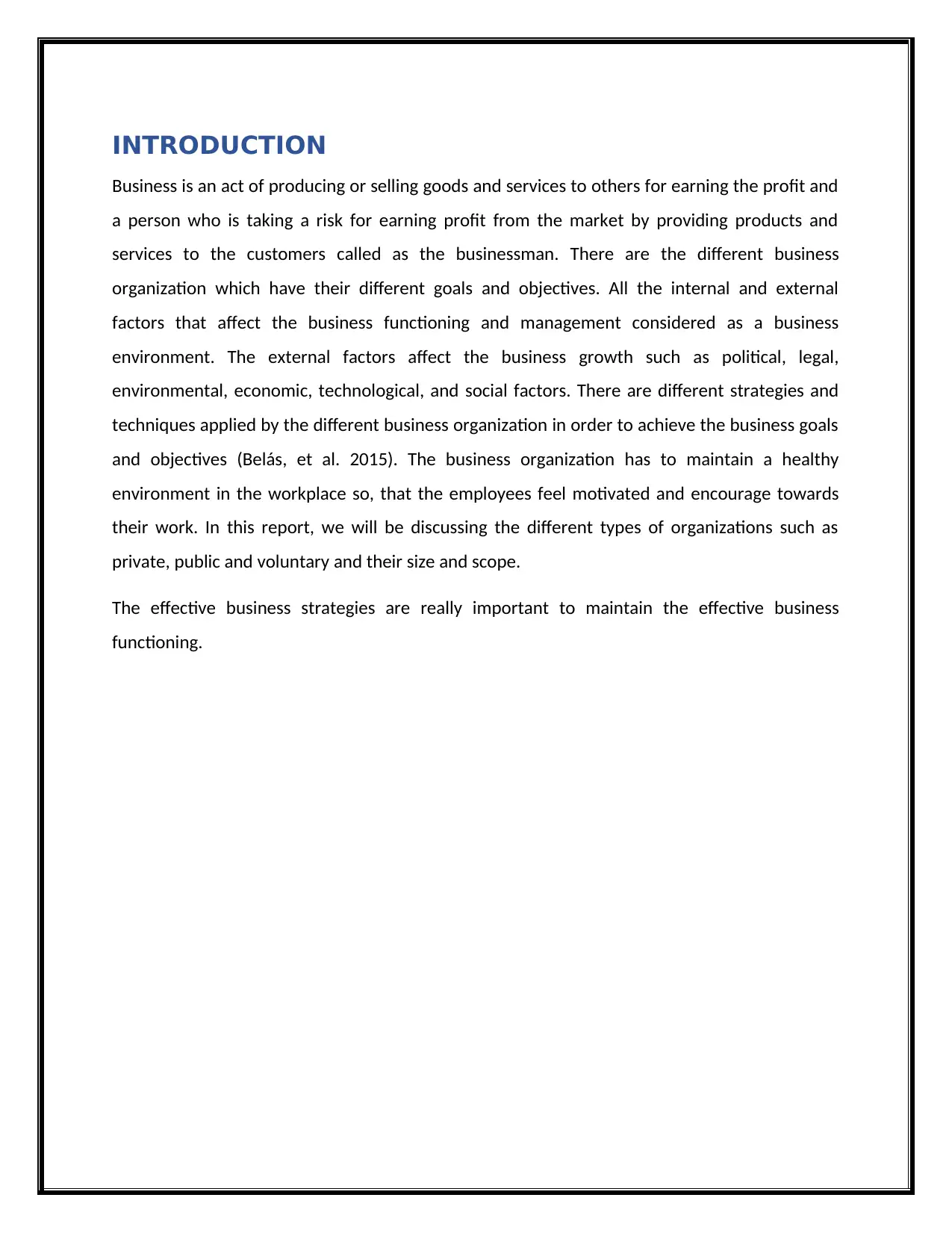
INTRODUCTION
Business is an act of producing or selling goods and services to others for earning the profit and
a person who is taking a risk for earning profit from the market by providing products and
services to the customers called as the businessman. There are the different business
organization which have their different goals and objectives. All the internal and external
factors that affect the business functioning and management considered as a business
environment. The external factors affect the business growth such as political, legal,
environmental, economic, technological, and social factors. There are different strategies and
techniques applied by the different business organization in order to achieve the business goals
and objectives (Belás, et al. 2015). The business organization has to maintain a healthy
environment in the workplace so, that the employees feel motivated and encourage towards
their work. In this report, we will be discussing the different types of organizations such as
private, public and voluntary and their size and scope.
The effective business strategies are really important to maintain the effective business
functioning.
Business is an act of producing or selling goods and services to others for earning the profit and
a person who is taking a risk for earning profit from the market by providing products and
services to the customers called as the businessman. There are the different business
organization which have their different goals and objectives. All the internal and external
factors that affect the business functioning and management considered as a business
environment. The external factors affect the business growth such as political, legal,
environmental, economic, technological, and social factors. There are different strategies and
techniques applied by the different business organization in order to achieve the business goals
and objectives (Belás, et al. 2015). The business organization has to maintain a healthy
environment in the workplace so, that the employees feel motivated and encourage towards
their work. In this report, we will be discussing the different types of organizations such as
private, public and voluntary and their size and scope.
The effective business strategies are really important to maintain the effective business
functioning.
Secure Best Marks with AI Grader
Need help grading? Try our AI Grader for instant feedback on your assignments.
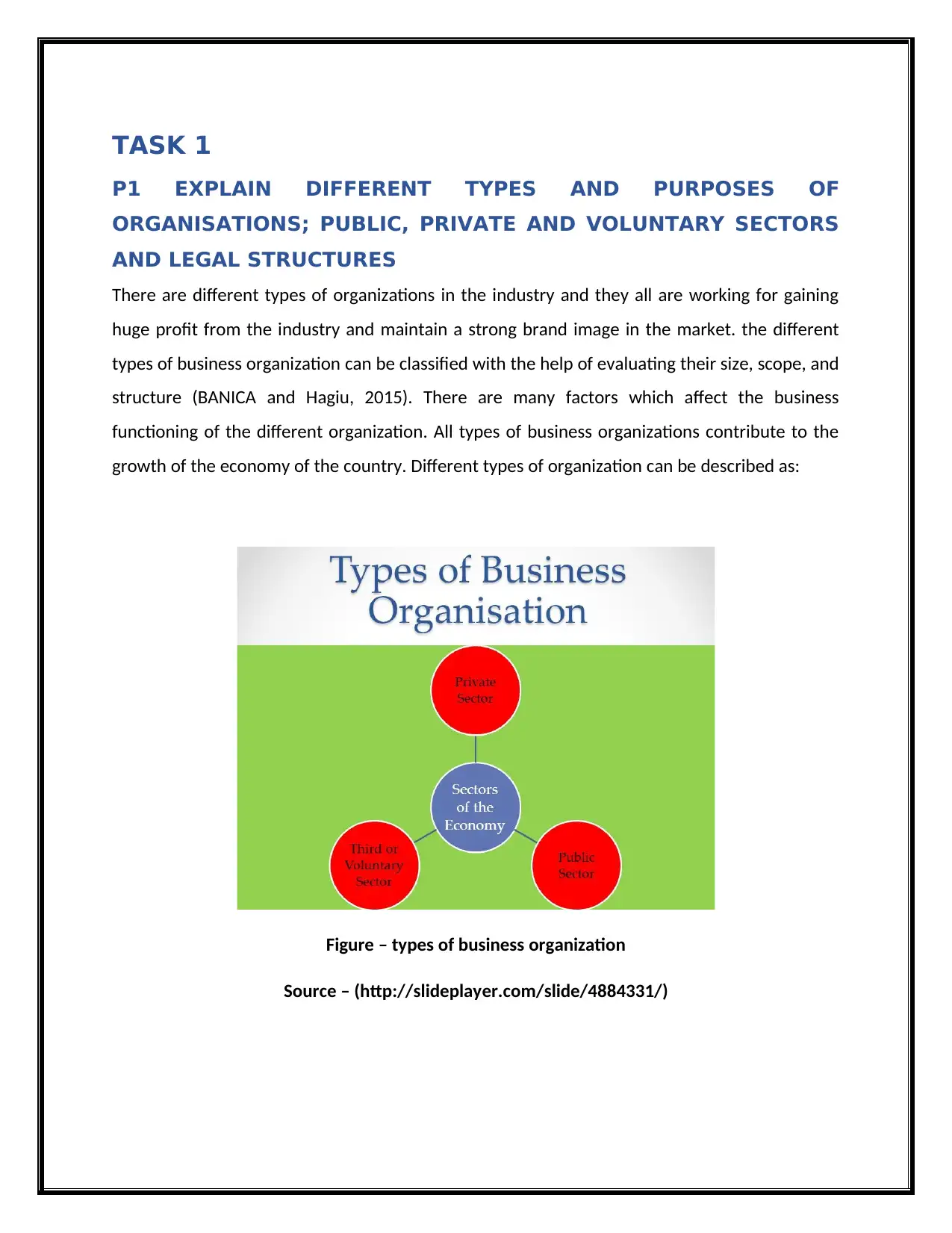
TASK 1
P1 EXPLAIN DIFFERENT TYPES AND PURPOSES OF
ORGANISATIONS; PUBLIC, PRIVATE AND VOLUNTARY SECTORS
AND LEGAL STRUCTURES
There are different types of organizations in the industry and they all are working for gaining
huge profit from the industry and maintain a strong brand image in the market. the different
types of business organization can be classified with the help of evaluating their size, scope, and
structure (BANICA and Hagiu, 2015). There are many factors which affect the business
functioning of the different organization. All types of business organizations contribute to the
growth of the economy of the country. Different types of organization can be described as:
Figure – types of business organization
Source – (http://slideplayer.com/slide/4884331/)
P1 EXPLAIN DIFFERENT TYPES AND PURPOSES OF
ORGANISATIONS; PUBLIC, PRIVATE AND VOLUNTARY SECTORS
AND LEGAL STRUCTURES
There are different types of organizations in the industry and they all are working for gaining
huge profit from the industry and maintain a strong brand image in the market. the different
types of business organization can be classified with the help of evaluating their size, scope, and
structure (BANICA and Hagiu, 2015). There are many factors which affect the business
functioning of the different organization. All types of business organizations contribute to the
growth of the economy of the country. Different types of organization can be described as:
Figure – types of business organization
Source – (http://slideplayer.com/slide/4884331/)
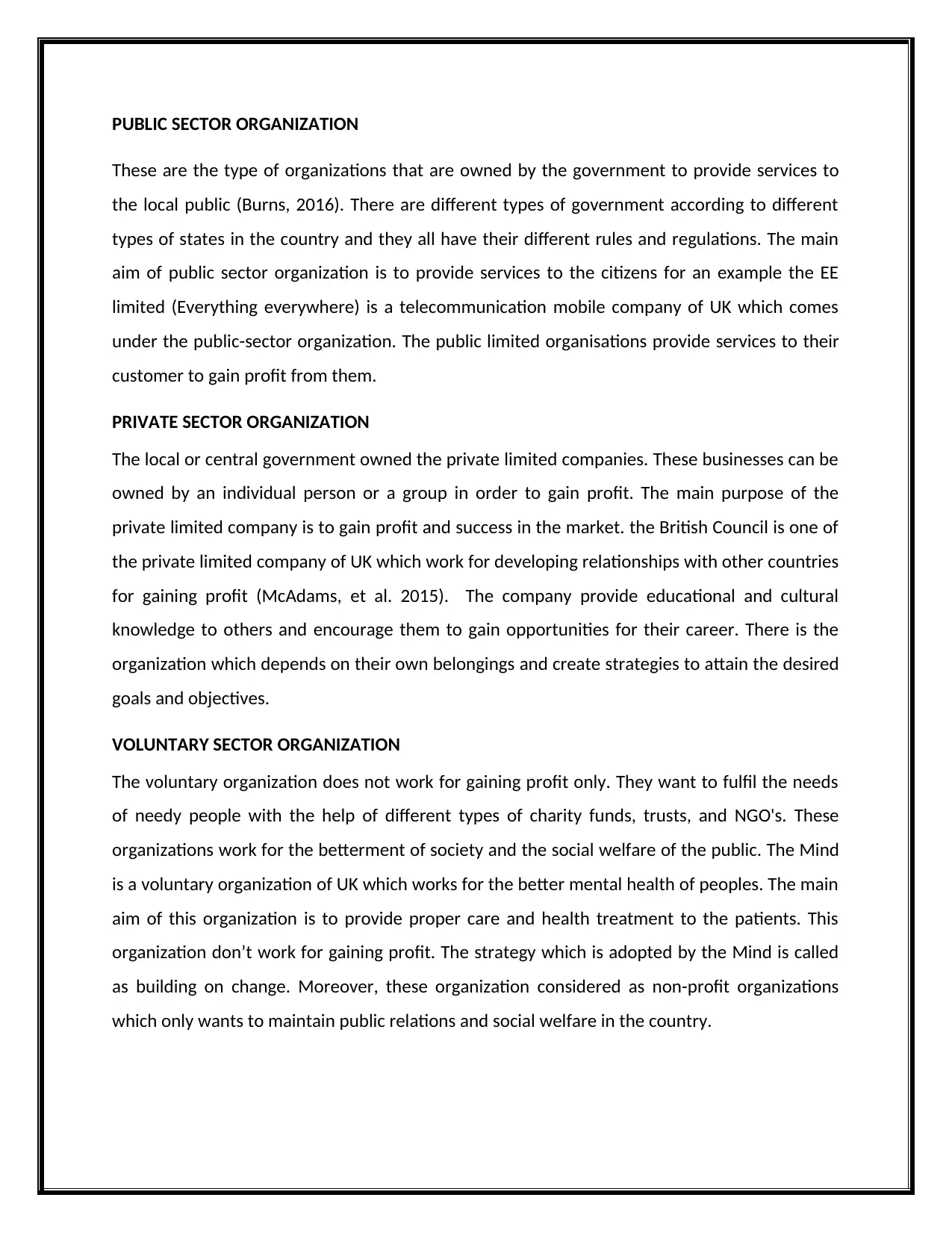
PUBLIC SECTOR ORGANIZATION
These are the type of organizations that are owned by the government to provide services to
the local public (Burns, 2016). There are different types of government according to different
types of states in the country and they all have their different rules and regulations. The main
aim of public sector organization is to provide services to the citizens for an example the EE
limited (Everything everywhere) is a telecommunication mobile company of UK which comes
under the public-sector organization. The public limited organisations provide services to their
customer to gain profit from them.
PRIVATE SECTOR ORGANIZATION
The local or central government owned the private limited companies. These businesses can be
owned by an individual person or a group in order to gain profit. The main purpose of the
private limited company is to gain profit and success in the market. the British Council is one of
the private limited company of UK which work for developing relationships with other countries
for gaining profit (McAdams, et al. 2015). The company provide educational and cultural
knowledge to others and encourage them to gain opportunities for their career. There is the
organization which depends on their own belongings and create strategies to attain the desired
goals and objectives.
VOLUNTARY SECTOR ORGANIZATION
The voluntary organization does not work for gaining profit only. They want to fulfil the needs
of needy people with the help of different types of charity funds, trusts, and NGO's. These
organizations work for the betterment of society and the social welfare of the public. The Mind
is a voluntary organization of UK which works for the better mental health of peoples. The main
aim of this organization is to provide proper care and health treatment to the patients. This
organization don’t work for gaining profit. The strategy which is adopted by the Mind is called
as building on change. Moreover, these organization considered as non-profit organizations
which only wants to maintain public relations and social welfare in the country.
These are the type of organizations that are owned by the government to provide services to
the local public (Burns, 2016). There are different types of government according to different
types of states in the country and they all have their different rules and regulations. The main
aim of public sector organization is to provide services to the citizens for an example the EE
limited (Everything everywhere) is a telecommunication mobile company of UK which comes
under the public-sector organization. The public limited organisations provide services to their
customer to gain profit from them.
PRIVATE SECTOR ORGANIZATION
The local or central government owned the private limited companies. These businesses can be
owned by an individual person or a group in order to gain profit. The main purpose of the
private limited company is to gain profit and success in the market. the British Council is one of
the private limited company of UK which work for developing relationships with other countries
for gaining profit (McAdams, et al. 2015). The company provide educational and cultural
knowledge to others and encourage them to gain opportunities for their career. There is the
organization which depends on their own belongings and create strategies to attain the desired
goals and objectives.
VOLUNTARY SECTOR ORGANIZATION
The voluntary organization does not work for gaining profit only. They want to fulfil the needs
of needy people with the help of different types of charity funds, trusts, and NGO's. These
organizations work for the betterment of society and the social welfare of the public. The Mind
is a voluntary organization of UK which works for the better mental health of peoples. The main
aim of this organization is to provide proper care and health treatment to the patients. This
organization don’t work for gaining profit. The strategy which is adopted by the Mind is called
as building on change. Moreover, these organization considered as non-profit organizations
which only wants to maintain public relations and social welfare in the country.
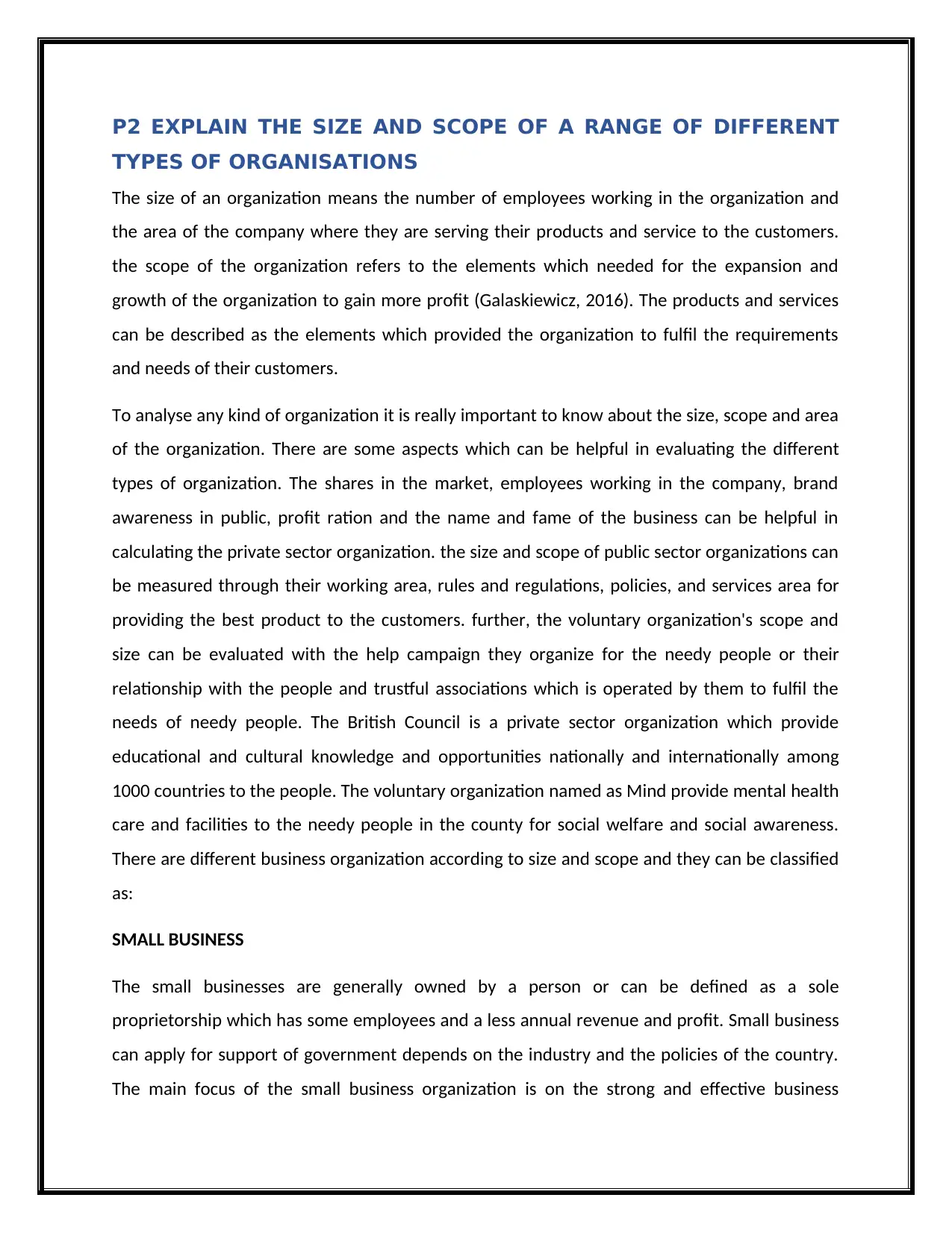
P2 EXPLAIN THE SIZE AND SCOPE OF A RANGE OF DIFFERENT
TYPES OF ORGANISATIONS
The size of an organization means the number of employees working in the organization and
the area of the company where they are serving their products and service to the customers.
the scope of the organization refers to the elements which needed for the expansion and
growth of the organization to gain more profit (Galaskiewicz, 2016). The products and services
can be described as the elements which provided the organization to fulfil the requirements
and needs of their customers.
To analyse any kind of organization it is really important to know about the size, scope and area
of the organization. There are some aspects which can be helpful in evaluating the different
types of organization. The shares in the market, employees working in the company, brand
awareness in public, profit ration and the name and fame of the business can be helpful in
calculating the private sector organization. the size and scope of public sector organizations can
be measured through their working area, rules and regulations, policies, and services area for
providing the best product to the customers. further, the voluntary organization's scope and
size can be evaluated with the help campaign they organize for the needy people or their
relationship with the people and trustful associations which is operated by them to fulfil the
needs of needy people. The British Council is a private sector organization which provide
educational and cultural knowledge and opportunities nationally and internationally among
1000 countries to the people. The voluntary organization named as Mind provide mental health
care and facilities to the needy people in the county for social welfare and social awareness.
There are different business organization according to size and scope and they can be classified
as:
SMALL BUSINESS
The small businesses are generally owned by a person or can be defined as a sole
proprietorship which has some employees and a less annual revenue and profit. Small business
can apply for support of government depends on the industry and the policies of the country.
The main focus of the small business organization is on the strong and effective business
TYPES OF ORGANISATIONS
The size of an organization means the number of employees working in the organization and
the area of the company where they are serving their products and service to the customers.
the scope of the organization refers to the elements which needed for the expansion and
growth of the organization to gain more profit (Galaskiewicz, 2016). The products and services
can be described as the elements which provided the organization to fulfil the requirements
and needs of their customers.
To analyse any kind of organization it is really important to know about the size, scope and area
of the organization. There are some aspects which can be helpful in evaluating the different
types of organization. The shares in the market, employees working in the company, brand
awareness in public, profit ration and the name and fame of the business can be helpful in
calculating the private sector organization. the size and scope of public sector organizations can
be measured through their working area, rules and regulations, policies, and services area for
providing the best product to the customers. further, the voluntary organization's scope and
size can be evaluated with the help campaign they organize for the needy people or their
relationship with the people and trustful associations which is operated by them to fulfil the
needs of needy people. The British Council is a private sector organization which provide
educational and cultural knowledge and opportunities nationally and internationally among
1000 countries to the people. The voluntary organization named as Mind provide mental health
care and facilities to the needy people in the county for social welfare and social awareness.
There are different business organization according to size and scope and they can be classified
as:
SMALL BUSINESS
The small businesses are generally owned by a person or can be defined as a sole
proprietorship which has some employees and a less annual revenue and profit. Small business
can apply for support of government depends on the industry and the policies of the country.
The main focus of the small business organization is on the strong and effective business
Paraphrase This Document
Need a fresh take? Get an instant paraphrase of this document with our AI Paraphraser
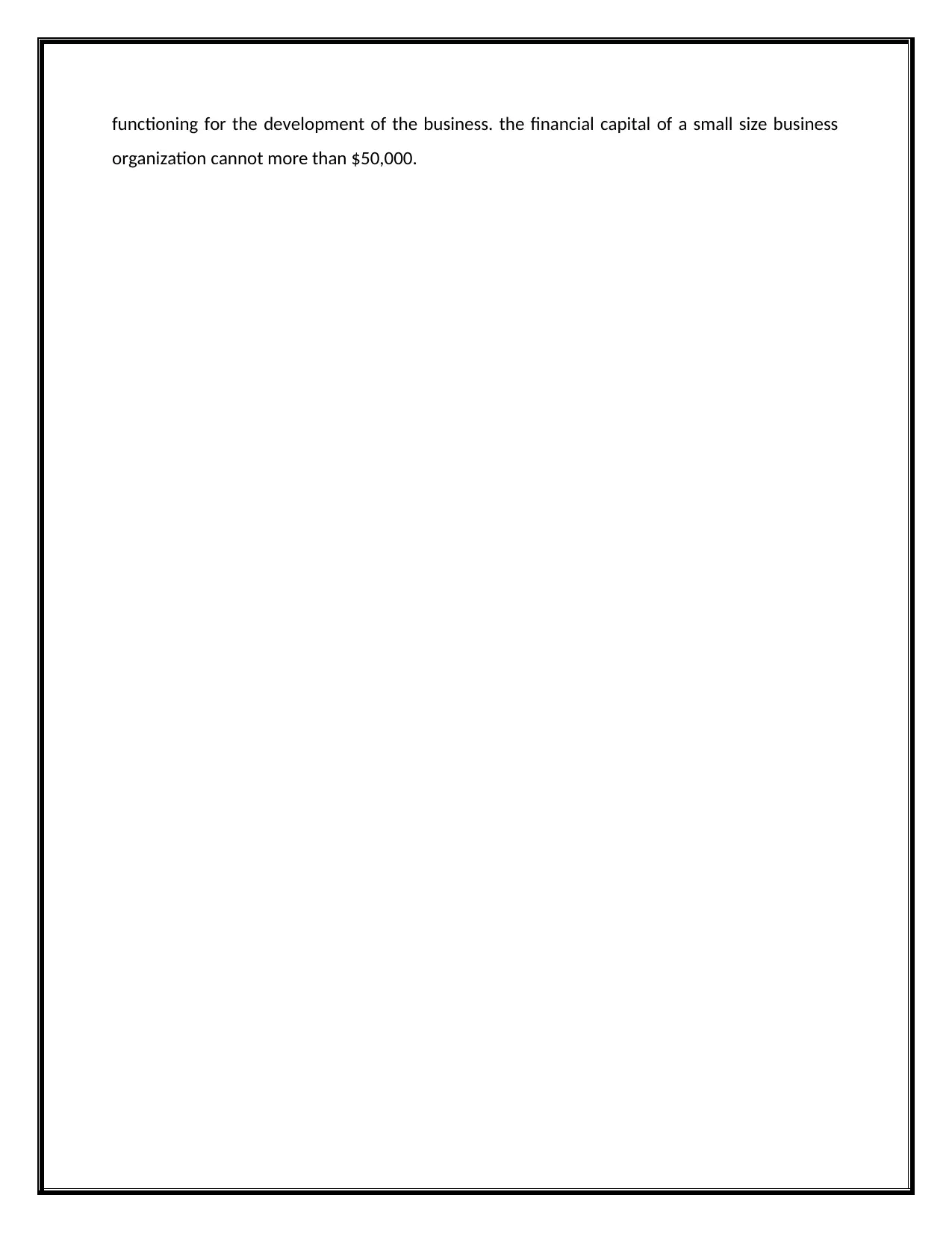
functioning for the development of the business. the financial capital of a small size business
organization cannot more than $50,000.
organization cannot more than $50,000.
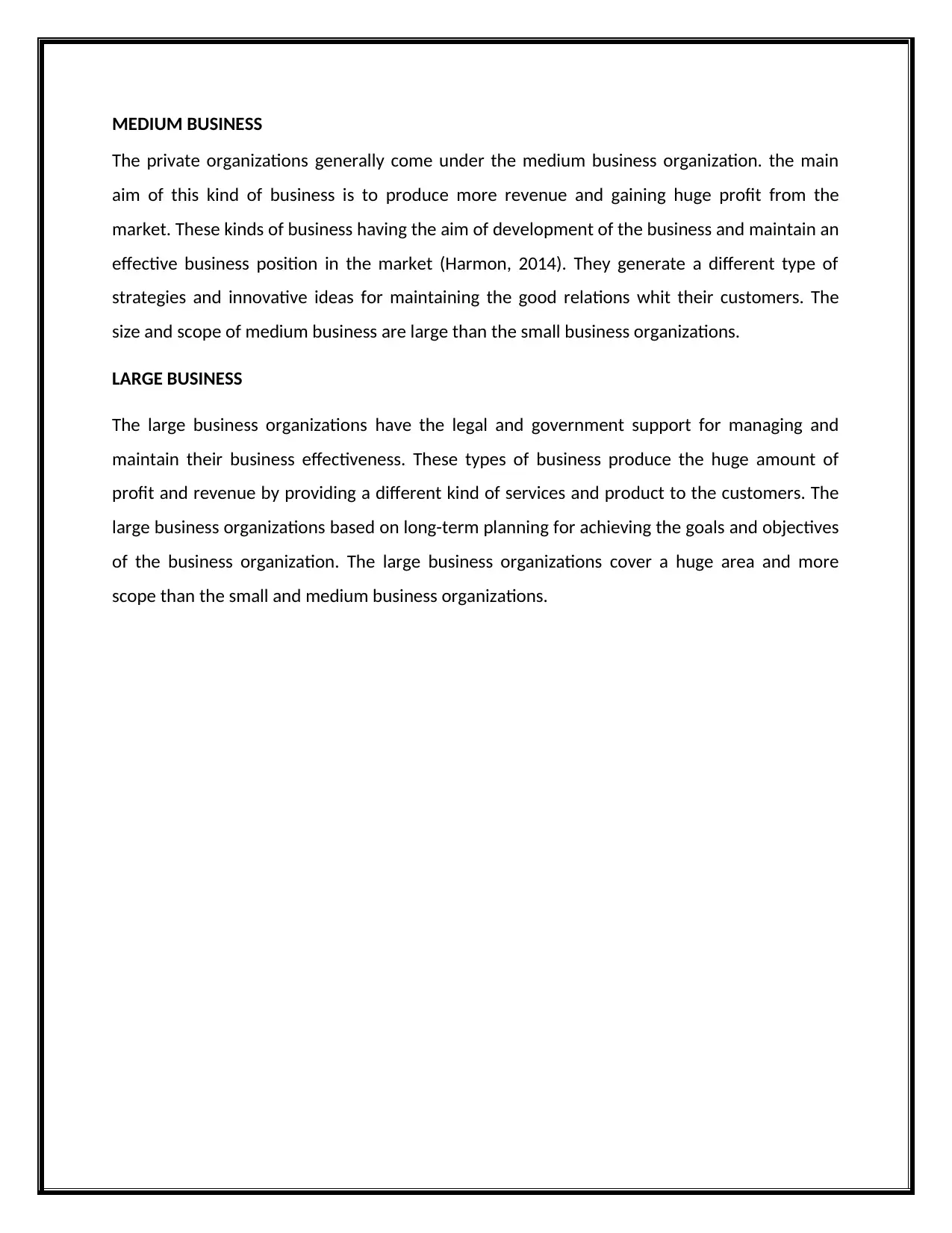
MEDIUM BUSINESS
The private organizations generally come under the medium business organization. the main
aim of this kind of business is to produce more revenue and gaining huge profit from the
market. These kinds of business having the aim of development of the business and maintain an
effective business position in the market (Harmon, 2014). They generate a different type of
strategies and innovative ideas for maintaining the good relations whit their customers. The
size and scope of medium business are large than the small business organizations.
LARGE BUSINESS
The large business organizations have the legal and government support for managing and
maintain their business effectiveness. These types of business produce the huge amount of
profit and revenue by providing a different kind of services and product to the customers. The
large business organizations based on long-term planning for achieving the goals and objectives
of the business organization. The large business organizations cover a huge area and more
scope than the small and medium business organizations.
The private organizations generally come under the medium business organization. the main
aim of this kind of business is to produce more revenue and gaining huge profit from the
market. These kinds of business having the aim of development of the business and maintain an
effective business position in the market (Harmon, 2014). They generate a different type of
strategies and innovative ideas for maintaining the good relations whit their customers. The
size and scope of medium business are large than the small business organizations.
LARGE BUSINESS
The large business organizations have the legal and government support for managing and
maintain their business effectiveness. These types of business produce the huge amount of
profit and revenue by providing a different kind of services and product to the customers. The
large business organizations based on long-term planning for achieving the goals and objectives
of the business organization. The large business organizations cover a huge area and more
scope than the small and medium business organizations.
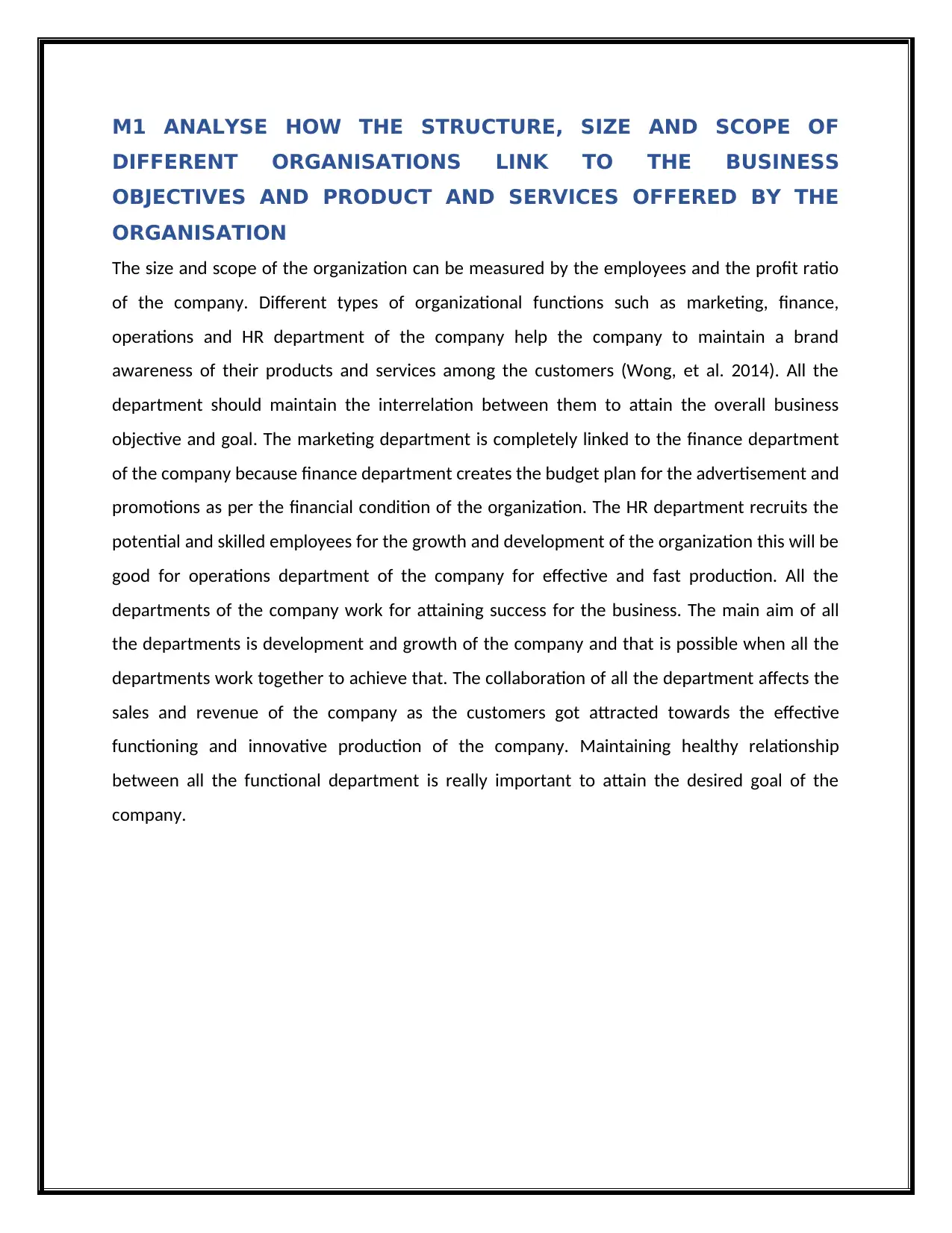
M1 ANALYSE HOW THE STRUCTURE, SIZE AND SCOPE OF
DIFFERENT ORGANISATIONS LINK TO THE BUSINESS
OBJECTIVES AND PRODUCT AND SERVICES OFFERED BY THE
ORGANISATION
The size and scope of the organization can be measured by the employees and the profit ratio
of the company. Different types of organizational functions such as marketing, finance,
operations and HR department of the company help the company to maintain a brand
awareness of their products and services among the customers (Wong, et al. 2014). All the
department should maintain the interrelation between them to attain the overall business
objective and goal. The marketing department is completely linked to the finance department
of the company because finance department creates the budget plan for the advertisement and
promotions as per the financial condition of the organization. The HR department recruits the
potential and skilled employees for the growth and development of the organization this will be
good for operations department of the company for effective and fast production. All the
departments of the company work for attaining success for the business. The main aim of all
the departments is development and growth of the company and that is possible when all the
departments work together to achieve that. The collaboration of all the department affects the
sales and revenue of the company as the customers got attracted towards the effective
functioning and innovative production of the company. Maintaining healthy relationship
between all the functional department is really important to attain the desired goal of the
company.
DIFFERENT ORGANISATIONS LINK TO THE BUSINESS
OBJECTIVES AND PRODUCT AND SERVICES OFFERED BY THE
ORGANISATION
The size and scope of the organization can be measured by the employees and the profit ratio
of the company. Different types of organizational functions such as marketing, finance,
operations and HR department of the company help the company to maintain a brand
awareness of their products and services among the customers (Wong, et al. 2014). All the
department should maintain the interrelation between them to attain the overall business
objective and goal. The marketing department is completely linked to the finance department
of the company because finance department creates the budget plan for the advertisement and
promotions as per the financial condition of the organization. The HR department recruits the
potential and skilled employees for the growth and development of the organization this will be
good for operations department of the company for effective and fast production. All the
departments of the company work for attaining success for the business. The main aim of all
the departments is development and growth of the company and that is possible when all the
departments work together to achieve that. The collaboration of all the department affects the
sales and revenue of the company as the customers got attracted towards the effective
functioning and innovative production of the company. Maintaining healthy relationship
between all the functional department is really important to attain the desired goal of the
company.
Secure Best Marks with AI Grader
Need help grading? Try our AI Grader for instant feedback on your assignments.
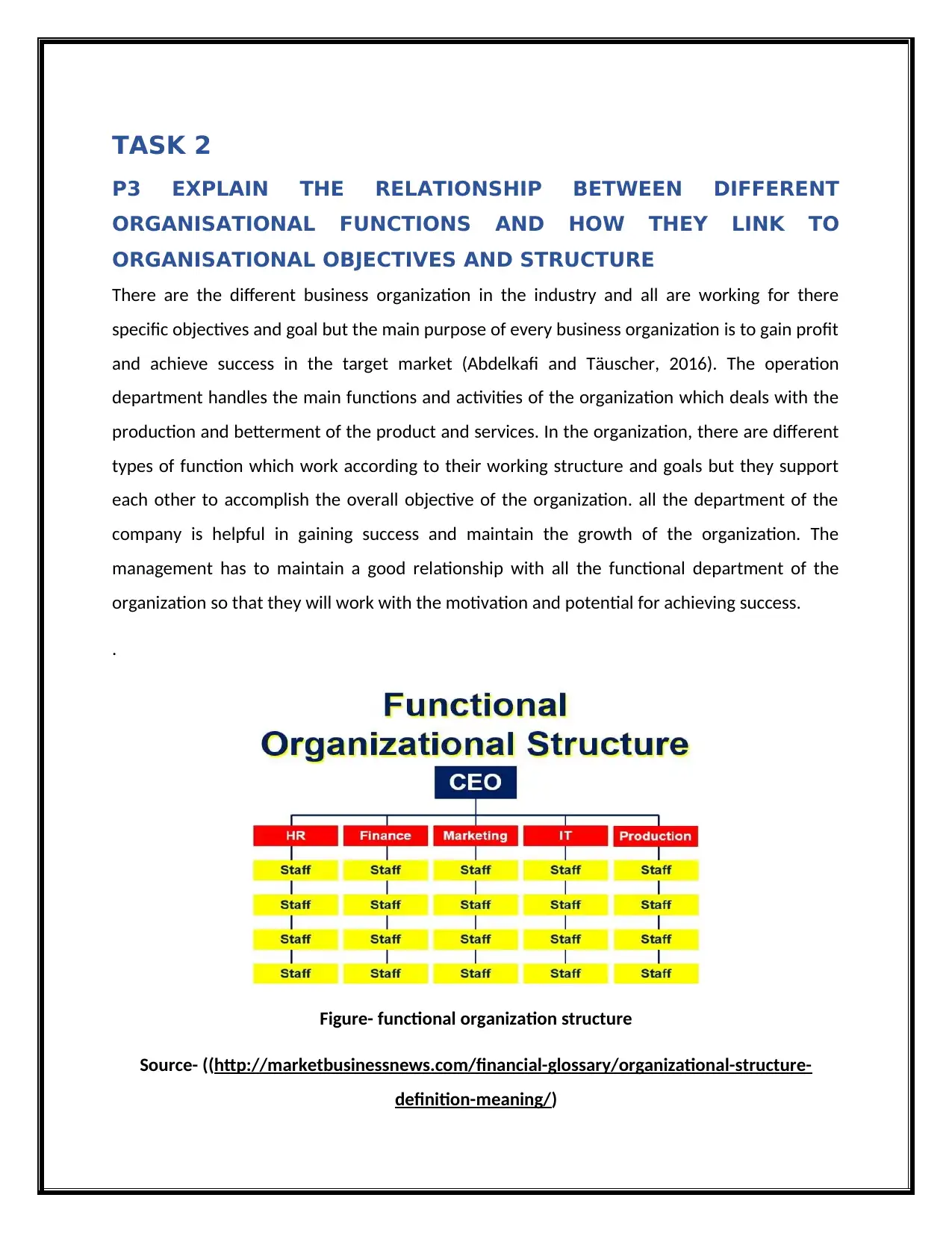
TASK 2
P3 EXPLAIN THE RELATIONSHIP BETWEEN DIFFERENT
ORGANISATIONAL FUNCTIONS AND HOW THEY LINK TO
ORGANISATIONAL OBJECTIVES AND STRUCTURE
There are the different business organization in the industry and all are working for there
specific objectives and goal but the main purpose of every business organization is to gain profit
and achieve success in the target market (Abdelkafi and Täuscher, 2016). The operation
department handles the main functions and activities of the organization which deals with the
production and betterment of the product and services. In the organization, there are different
types of function which work according to their working structure and goals but they support
each other to accomplish the overall objective of the organization. all the department of the
company is helpful in gaining success and maintain the growth of the organization. The
management has to maintain a good relationship with all the functional department of the
organization so that they will work with the motivation and potential for achieving success.
.
Figure- functional organization structure
Source- ((http://marketbusinessnews.com/financial-glossary/organizational-structure-
definition-meaning/)
P3 EXPLAIN THE RELATIONSHIP BETWEEN DIFFERENT
ORGANISATIONAL FUNCTIONS AND HOW THEY LINK TO
ORGANISATIONAL OBJECTIVES AND STRUCTURE
There are the different business organization in the industry and all are working for there
specific objectives and goal but the main purpose of every business organization is to gain profit
and achieve success in the target market (Abdelkafi and Täuscher, 2016). The operation
department handles the main functions and activities of the organization which deals with the
production and betterment of the product and services. In the organization, there are different
types of function which work according to their working structure and goals but they support
each other to accomplish the overall objective of the organization. all the department of the
company is helpful in gaining success and maintain the growth of the organization. The
management has to maintain a good relationship with all the functional department of the
organization so that they will work with the motivation and potential for achieving success.
.
Figure- functional organization structure
Source- ((http://marketbusinessnews.com/financial-glossary/organizational-structure-
definition-meaning/)

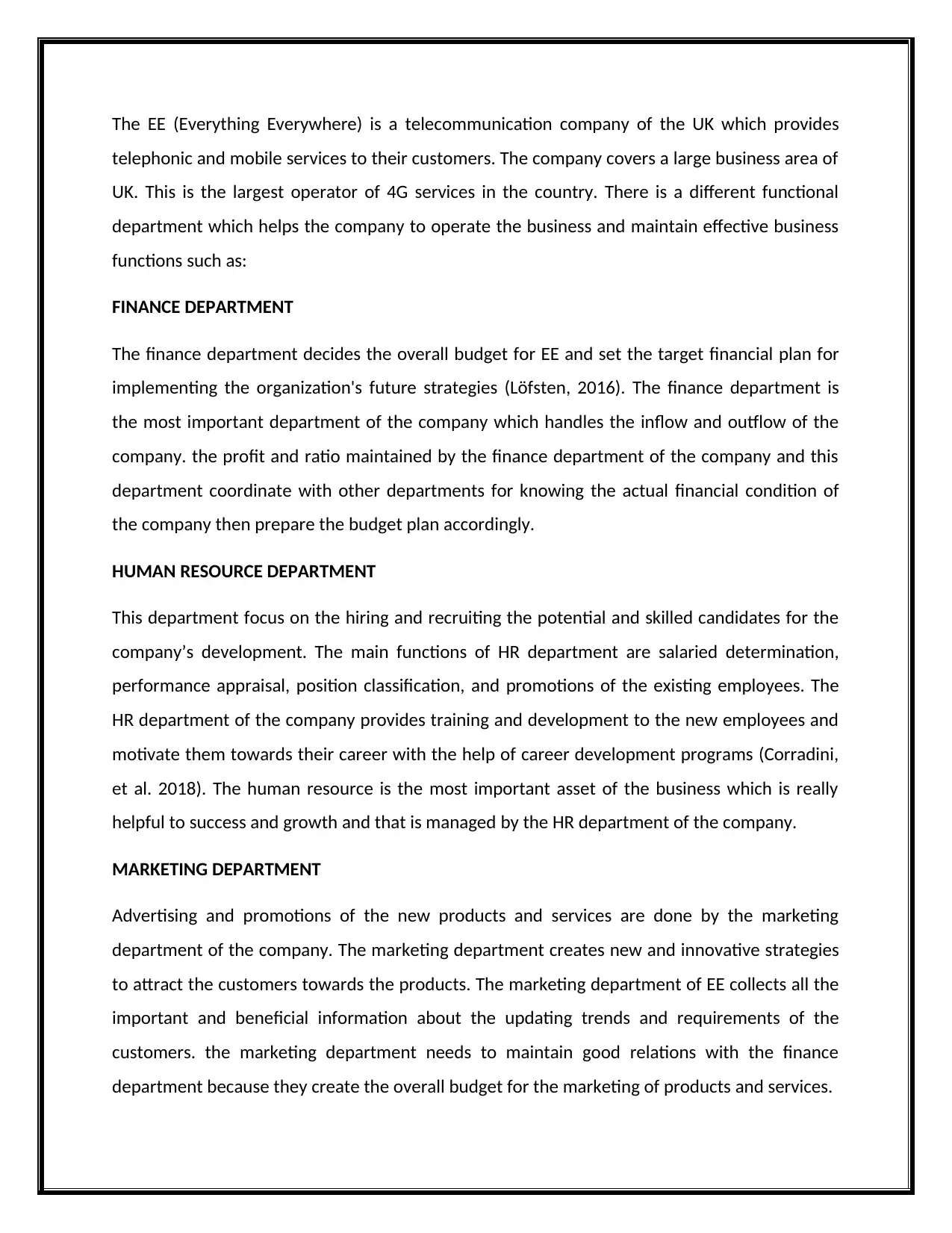
The EE (Everything Everywhere) is a telecommunication company of the UK which provides
telephonic and mobile services to their customers. The company covers a large business area of
UK. This is the largest operator of 4G services in the country. There is a different functional
department which helps the company to operate the business and maintain effective business
functions such as:
FINANCE DEPARTMENT
The finance department decides the overall budget for EE and set the target financial plan for
implementing the organization's future strategies (Löfsten, 2016). The finance department is
the most important department of the company which handles the inflow and outflow of the
company. the profit and ratio maintained by the finance department of the company and this
department coordinate with other departments for knowing the actual financial condition of
the company then prepare the budget plan accordingly.
HUMAN RESOURCE DEPARTMENT
This department focus on the hiring and recruiting the potential and skilled candidates for the
company’s development. The main functions of HR department are salaried determination,
performance appraisal, position classification, and promotions of the existing employees. The
HR department of the company provides training and development to the new employees and
motivate them towards their career with the help of career development programs (Corradini,
et al. 2018). The human resource is the most important asset of the business which is really
helpful to success and growth and that is managed by the HR department of the company.
MARKETING DEPARTMENT
Advertising and promotions of the new products and services are done by the marketing
department of the company. The marketing department creates new and innovative strategies
to attract the customers towards the products. The marketing department of EE collects all the
important and beneficial information about the updating trends and requirements of the
customers. the marketing department needs to maintain good relations with the finance
department because they create the overall budget for the marketing of products and services.
telephonic and mobile services to their customers. The company covers a large business area of
UK. This is the largest operator of 4G services in the country. There is a different functional
department which helps the company to operate the business and maintain effective business
functions such as:
FINANCE DEPARTMENT
The finance department decides the overall budget for EE and set the target financial plan for
implementing the organization's future strategies (Löfsten, 2016). The finance department is
the most important department of the company which handles the inflow and outflow of the
company. the profit and ratio maintained by the finance department of the company and this
department coordinate with other departments for knowing the actual financial condition of
the company then prepare the budget plan accordingly.
HUMAN RESOURCE DEPARTMENT
This department focus on the hiring and recruiting the potential and skilled candidates for the
company’s development. The main functions of HR department are salaried determination,
performance appraisal, position classification, and promotions of the existing employees. The
HR department of the company provides training and development to the new employees and
motivate them towards their career with the help of career development programs (Corradini,
et al. 2018). The human resource is the most important asset of the business which is really
helpful to success and growth and that is managed by the HR department of the company.
MARKETING DEPARTMENT
Advertising and promotions of the new products and services are done by the marketing
department of the company. The marketing department creates new and innovative strategies
to attract the customers towards the products. The marketing department of EE collects all the
important and beneficial information about the updating trends and requirements of the
customers. the marketing department needs to maintain good relations with the finance
department because they create the overall budget for the marketing of products and services.
Paraphrase This Document
Need a fresh take? Get an instant paraphrase of this document with our AI Paraphraser
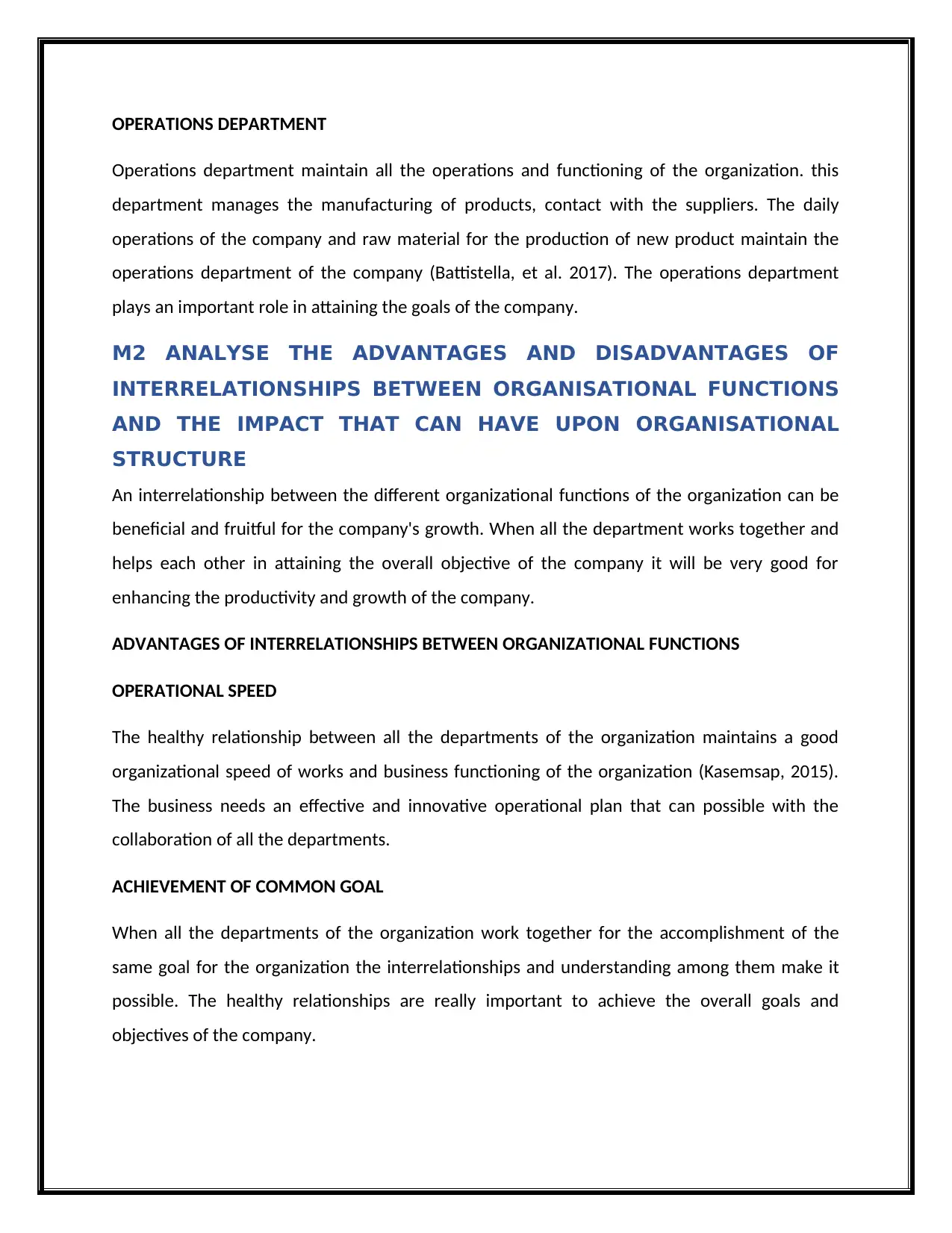
OPERATIONS DEPARTMENT
Operations department maintain all the operations and functioning of the organization. this
department manages the manufacturing of products, contact with the suppliers. The daily
operations of the company and raw material for the production of new product maintain the
operations department of the company (Battistella, et al. 2017). The operations department
plays an important role in attaining the goals of the company.
M2 ANALYSE THE ADVANTAGES AND DISADVANTAGES OF
INTERRELATIONSHIPS BETWEEN ORGANISATIONAL FUNCTIONS
AND THE IMPACT THAT CAN HAVE UPON ORGANISATIONAL
STRUCTURE
An interrelationship between the different organizational functions of the organization can be
beneficial and fruitful for the company's growth. When all the department works together and
helps each other in attaining the overall objective of the company it will be very good for
enhancing the productivity and growth of the company.
ADVANTAGES OF INTERRELATIONSHIPS BETWEEN ORGANIZATIONAL FUNCTIONS
OPERATIONAL SPEED
The healthy relationship between all the departments of the organization maintains a good
organizational speed of works and business functioning of the organization (Kasemsap, 2015).
The business needs an effective and innovative operational plan that can possible with the
collaboration of all the departments.
ACHIEVEMENT OF COMMON GOAL
When all the departments of the organization work together for the accomplishment of the
same goal for the organization the interrelationships and understanding among them make it
possible. The healthy relationships are really important to achieve the overall goals and
objectives of the company.
Operations department maintain all the operations and functioning of the organization. this
department manages the manufacturing of products, contact with the suppliers. The daily
operations of the company and raw material for the production of new product maintain the
operations department of the company (Battistella, et al. 2017). The operations department
plays an important role in attaining the goals of the company.
M2 ANALYSE THE ADVANTAGES AND DISADVANTAGES OF
INTERRELATIONSHIPS BETWEEN ORGANISATIONAL FUNCTIONS
AND THE IMPACT THAT CAN HAVE UPON ORGANISATIONAL
STRUCTURE
An interrelationship between the different organizational functions of the organization can be
beneficial and fruitful for the company's growth. When all the department works together and
helps each other in attaining the overall objective of the company it will be very good for
enhancing the productivity and growth of the company.
ADVANTAGES OF INTERRELATIONSHIPS BETWEEN ORGANIZATIONAL FUNCTIONS
OPERATIONAL SPEED
The healthy relationship between all the departments of the organization maintains a good
organizational speed of works and business functioning of the organization (Kasemsap, 2015).
The business needs an effective and innovative operational plan that can possible with the
collaboration of all the departments.
ACHIEVEMENT OF COMMON GOAL
When all the departments of the organization work together for the accomplishment of the
same goal for the organization the interrelationships and understanding among them make it
possible. The healthy relationships are really important to achieve the overall goals and
objectives of the company.
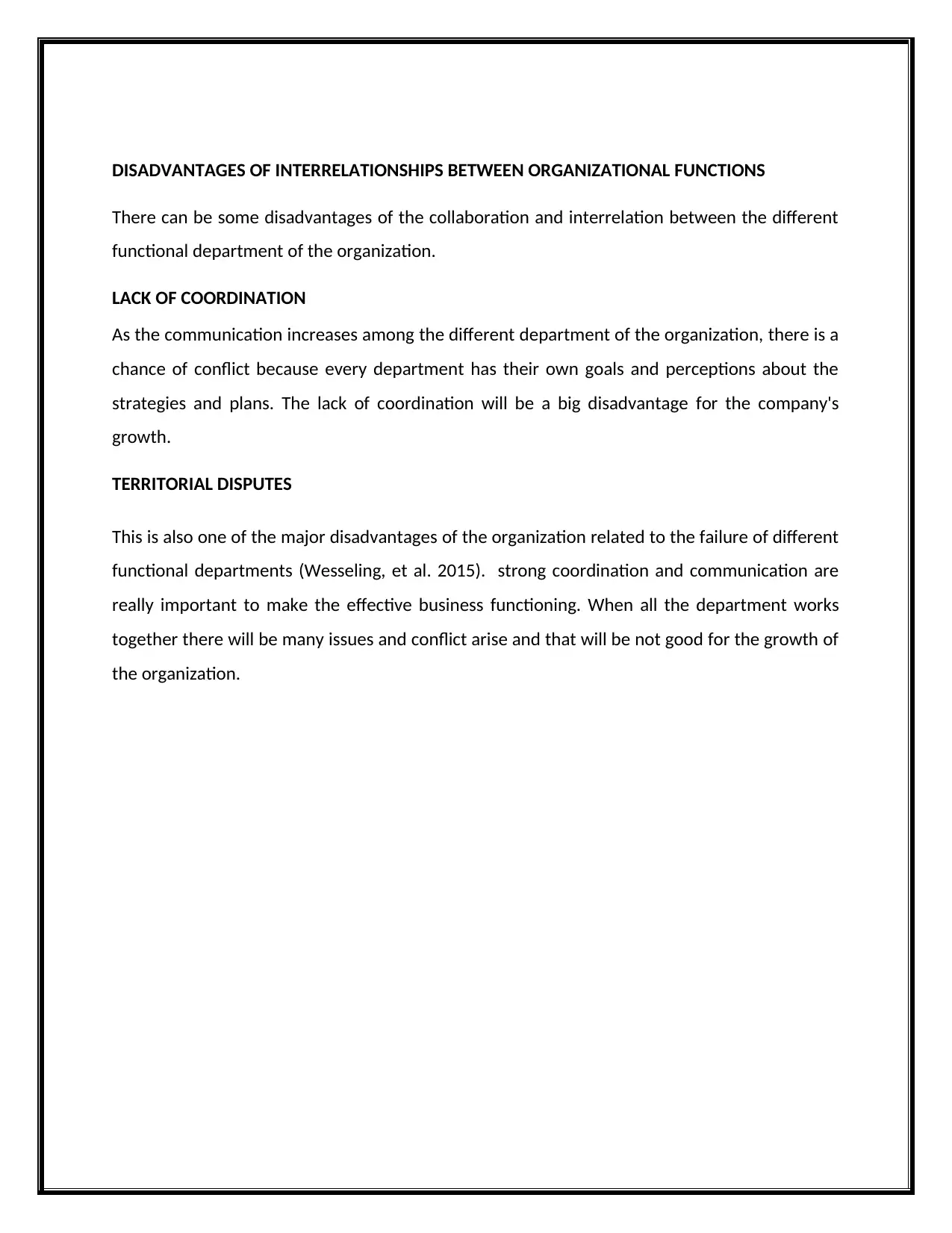
DISADVANTAGES OF INTERRELATIONSHIPS BETWEEN ORGANIZATIONAL FUNCTIONS
There can be some disadvantages of the collaboration and interrelation between the different
functional department of the organization.
LACK OF COORDINATION
As the communication increases among the different department of the organization, there is a
chance of conflict because every department has their own goals and perceptions about the
strategies and plans. The lack of coordination will be a big disadvantage for the company's
growth.
TERRITORIAL DISPUTES
This is also one of the major disadvantages of the organization related to the failure of different
functional departments (Wesseling, et al. 2015). strong coordination and communication are
really important to make the effective business functioning. When all the department works
together there will be many issues and conflict arise and that will be not good for the growth of
the organization.
There can be some disadvantages of the collaboration and interrelation between the different
functional department of the organization.
LACK OF COORDINATION
As the communication increases among the different department of the organization, there is a
chance of conflict because every department has their own goals and perceptions about the
strategies and plans. The lack of coordination will be a big disadvantage for the company's
growth.
TERRITORIAL DISPUTES
This is also one of the major disadvantages of the organization related to the failure of different
functional departments (Wesseling, et al. 2015). strong coordination and communication are
really important to make the effective business functioning. When all the department works
together there will be many issues and conflict arise and that will be not good for the growth of
the organization.
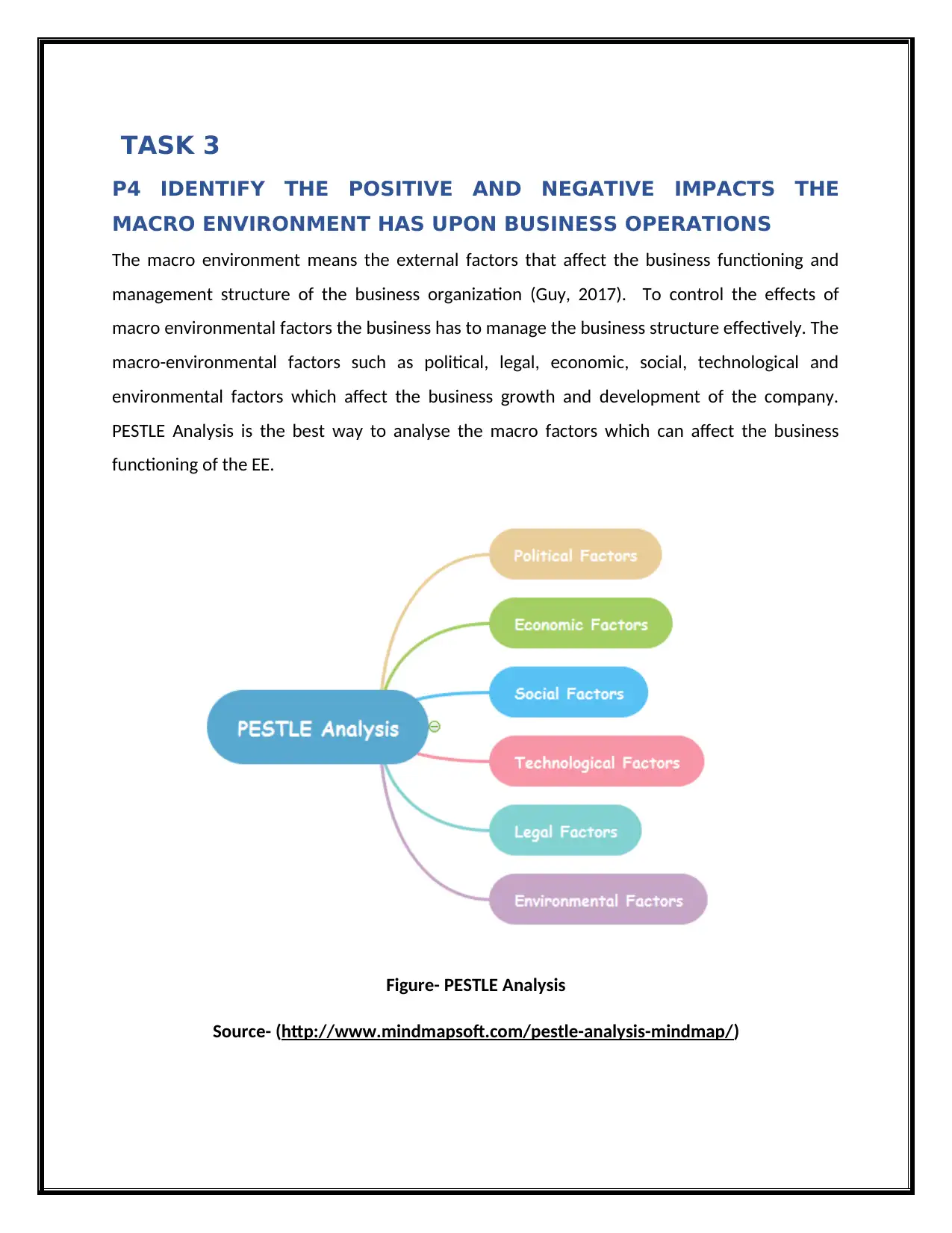
TASK 3
P4 IDENTIFY THE POSITIVE AND NEGATIVE IMPACTS THE
MACRO ENVIRONMENT HAS UPON BUSINESS OPERATIONS
The macro environment means the external factors that affect the business functioning and
management structure of the business organization (Guy, 2017). To control the effects of
macro environmental factors the business has to manage the business structure effectively. The
macro-environmental factors such as political, legal, economic, social, technological and
environmental factors which affect the business growth and development of the company.
PESTLE Analysis is the best way to analyse the macro factors which can affect the business
functioning of the EE.
Figure- PESTLE Analysis
Source- (http://www.mindmapsoft.com/pestle-analysis-mindmap/)
P4 IDENTIFY THE POSITIVE AND NEGATIVE IMPACTS THE
MACRO ENVIRONMENT HAS UPON BUSINESS OPERATIONS
The macro environment means the external factors that affect the business functioning and
management structure of the business organization (Guy, 2017). To control the effects of
macro environmental factors the business has to manage the business structure effectively. The
macro-environmental factors such as political, legal, economic, social, technological and
environmental factors which affect the business growth and development of the company.
PESTLE Analysis is the best way to analyse the macro factors which can affect the business
functioning of the EE.
Figure- PESTLE Analysis
Source- (http://www.mindmapsoft.com/pestle-analysis-mindmap/)
Secure Best Marks with AI Grader
Need help grading? Try our AI Grader for instant feedback on your assignments.
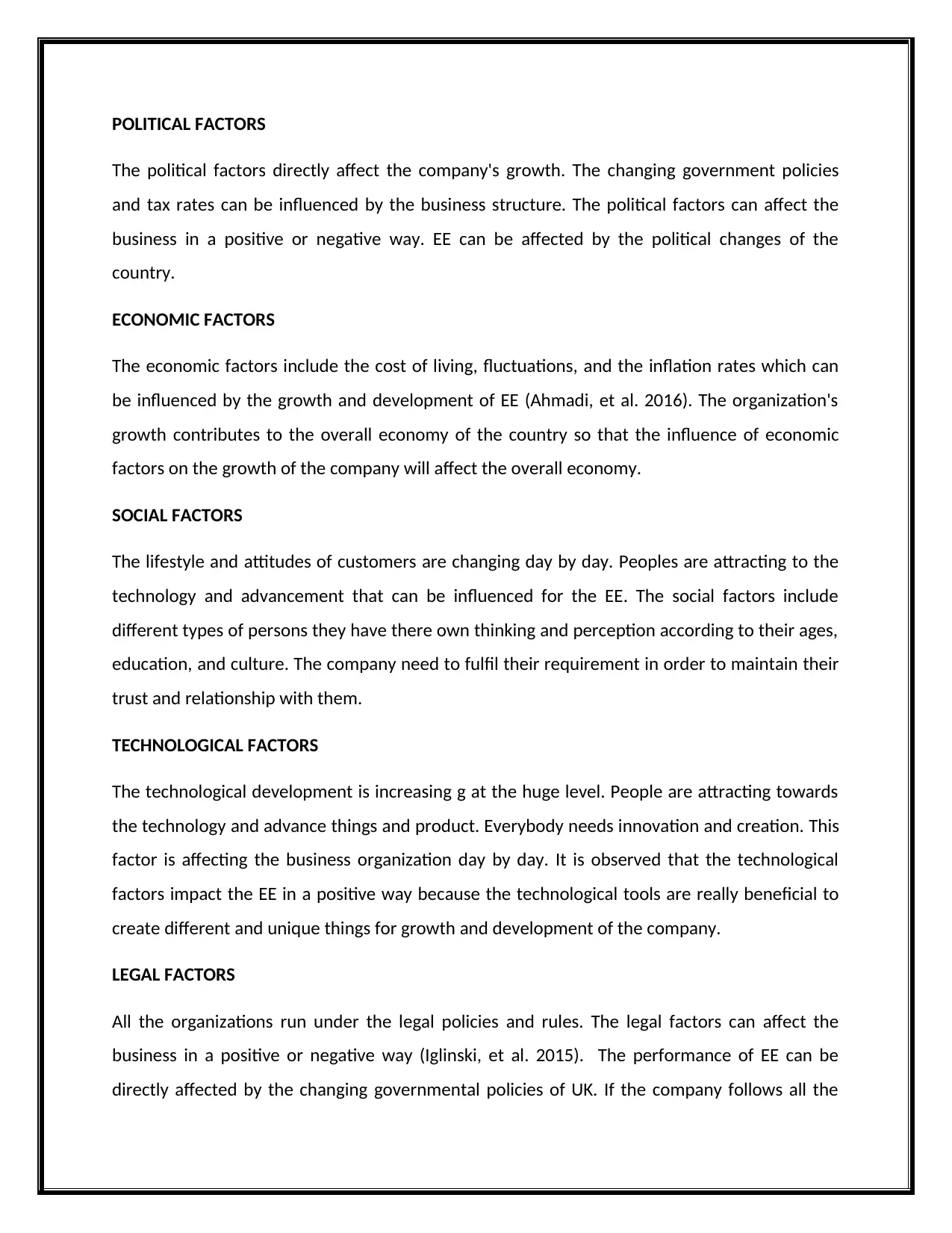
POLITICAL FACTORS
The political factors directly affect the company's growth. The changing government policies
and tax rates can be influenced by the business structure. The political factors can affect the
business in a positive or negative way. EE can be affected by the political changes of the
country.
ECONOMIC FACTORS
The economic factors include the cost of living, fluctuations, and the inflation rates which can
be influenced by the growth and development of EE (Ahmadi, et al. 2016). The organization's
growth contributes to the overall economy of the country so that the influence of economic
factors on the growth of the company will affect the overall economy.
SOCIAL FACTORS
The lifestyle and attitudes of customers are changing day by day. Peoples are attracting to the
technology and advancement that can be influenced for the EE. The social factors include
different types of persons they have there own thinking and perception according to their ages,
education, and culture. The company need to fulfil their requirement in order to maintain their
trust and relationship with them.
TECHNOLOGICAL FACTORS
The technological development is increasing g at the huge level. People are attracting towards
the technology and advance things and product. Everybody needs innovation and creation. This
factor is affecting the business organization day by day. It is observed that the technological
factors impact the EE in a positive way because the technological tools are really beneficial to
create different and unique things for growth and development of the company.
LEGAL FACTORS
All the organizations run under the legal policies and rules. The legal factors can affect the
business in a positive or negative way (Iglinski, et al. 2015). The performance of EE can be
directly affected by the changing governmental policies of UK. If the company follows all the
The political factors directly affect the company's growth. The changing government policies
and tax rates can be influenced by the business structure. The political factors can affect the
business in a positive or negative way. EE can be affected by the political changes of the
country.
ECONOMIC FACTORS
The economic factors include the cost of living, fluctuations, and the inflation rates which can
be influenced by the growth and development of EE (Ahmadi, et al. 2016). The organization's
growth contributes to the overall economy of the country so that the influence of economic
factors on the growth of the company will affect the overall economy.
SOCIAL FACTORS
The lifestyle and attitudes of customers are changing day by day. Peoples are attracting to the
technology and advancement that can be influenced for the EE. The social factors include
different types of persons they have there own thinking and perception according to their ages,
education, and culture. The company need to fulfil their requirement in order to maintain their
trust and relationship with them.
TECHNOLOGICAL FACTORS
The technological development is increasing g at the huge level. People are attracting towards
the technology and advance things and product. Everybody needs innovation and creation. This
factor is affecting the business organization day by day. It is observed that the technological
factors impact the EE in a positive way because the technological tools are really beneficial to
create different and unique things for growth and development of the company.
LEGAL FACTORS
All the organizations run under the legal policies and rules. The legal factors can affect the
business in a positive or negative way (Iglinski, et al. 2015). The performance of EE can be
directly affected by the changing governmental policies of UK. If the company follows all the
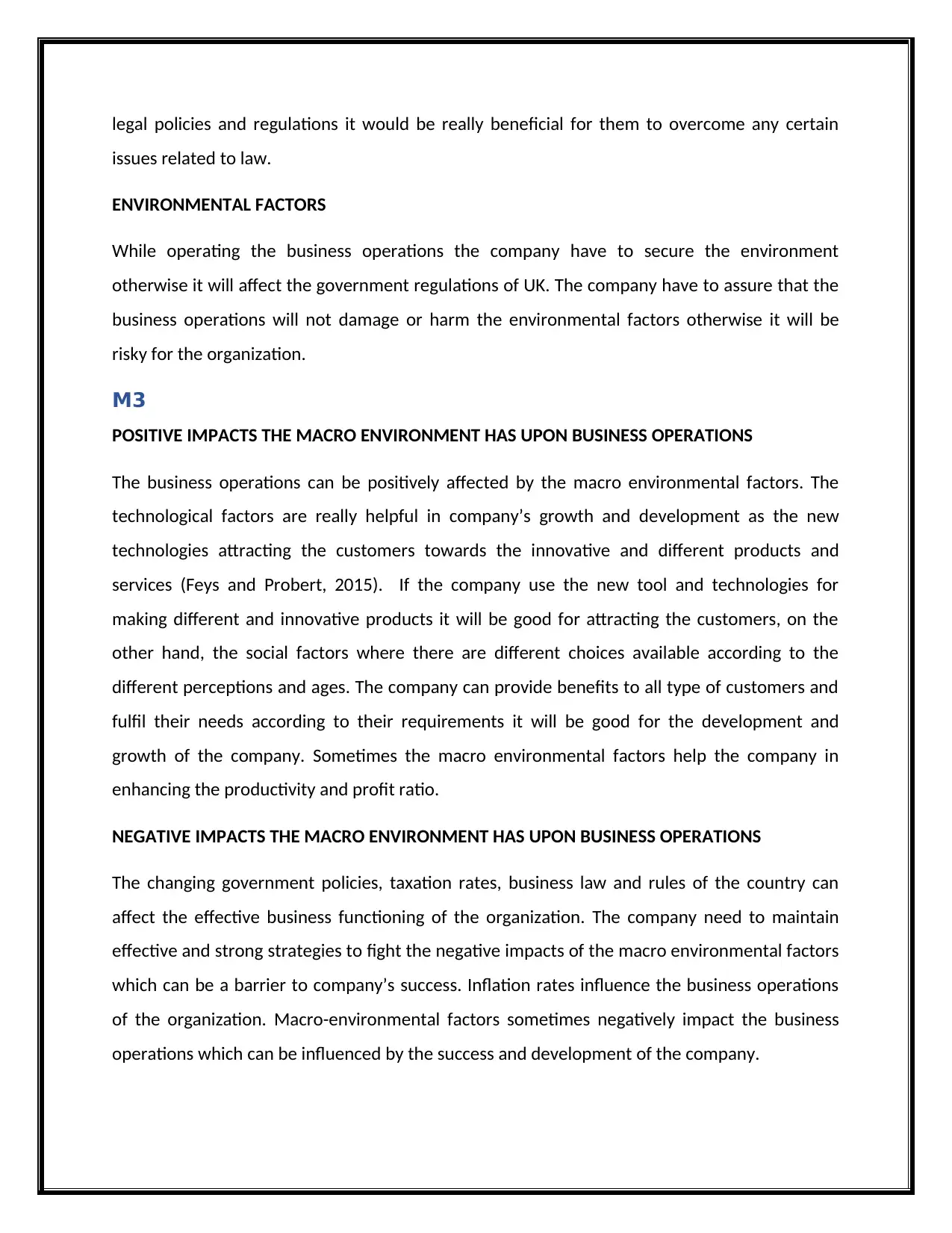
legal policies and regulations it would be really beneficial for them to overcome any certain
issues related to law.
ENVIRONMENTAL FACTORS
While operating the business operations the company have to secure the environment
otherwise it will affect the government regulations of UK. The company have to assure that the
business operations will not damage or harm the environmental factors otherwise it will be
risky for the organization.
M3
POSITIVE IMPACTS THE MACRO ENVIRONMENT HAS UPON BUSINESS OPERATIONS
The business operations can be positively affected by the macro environmental factors. The
technological factors are really helpful in company’s growth and development as the new
technologies attracting the customers towards the innovative and different products and
services (Feys and Probert, 2015). If the company use the new tool and technologies for
making different and innovative products it will be good for attracting the customers, on the
other hand, the social factors where there are different choices available according to the
different perceptions and ages. The company can provide benefits to all type of customers and
fulfil their needs according to their requirements it will be good for the development and
growth of the company. Sometimes the macro environmental factors help the company in
enhancing the productivity and profit ratio.
NEGATIVE IMPACTS THE MACRO ENVIRONMENT HAS UPON BUSINESS OPERATIONS
The changing government policies, taxation rates, business law and rules of the country can
affect the effective business functioning of the organization. The company need to maintain
effective and strong strategies to fight the negative impacts of the macro environmental factors
which can be a barrier to company’s success. Inflation rates influence the business operations
of the organization. Macro-environmental factors sometimes negatively impact the business
operations which can be influenced by the success and development of the company.
issues related to law.
ENVIRONMENTAL FACTORS
While operating the business operations the company have to secure the environment
otherwise it will affect the government regulations of UK. The company have to assure that the
business operations will not damage or harm the environmental factors otherwise it will be
risky for the organization.
M3
POSITIVE IMPACTS THE MACRO ENVIRONMENT HAS UPON BUSINESS OPERATIONS
The business operations can be positively affected by the macro environmental factors. The
technological factors are really helpful in company’s growth and development as the new
technologies attracting the customers towards the innovative and different products and
services (Feys and Probert, 2015). If the company use the new tool and technologies for
making different and innovative products it will be good for attracting the customers, on the
other hand, the social factors where there are different choices available according to the
different perceptions and ages. The company can provide benefits to all type of customers and
fulfil their needs according to their requirements it will be good for the development and
growth of the company. Sometimes the macro environmental factors help the company in
enhancing the productivity and profit ratio.
NEGATIVE IMPACTS THE MACRO ENVIRONMENT HAS UPON BUSINESS OPERATIONS
The changing government policies, taxation rates, business law and rules of the country can
affect the effective business functioning of the organization. The company need to maintain
effective and strong strategies to fight the negative impacts of the macro environmental factors
which can be a barrier to company’s success. Inflation rates influence the business operations
of the organization. Macro-environmental factors sometimes negatively impact the business
operations which can be influenced by the success and development of the company.
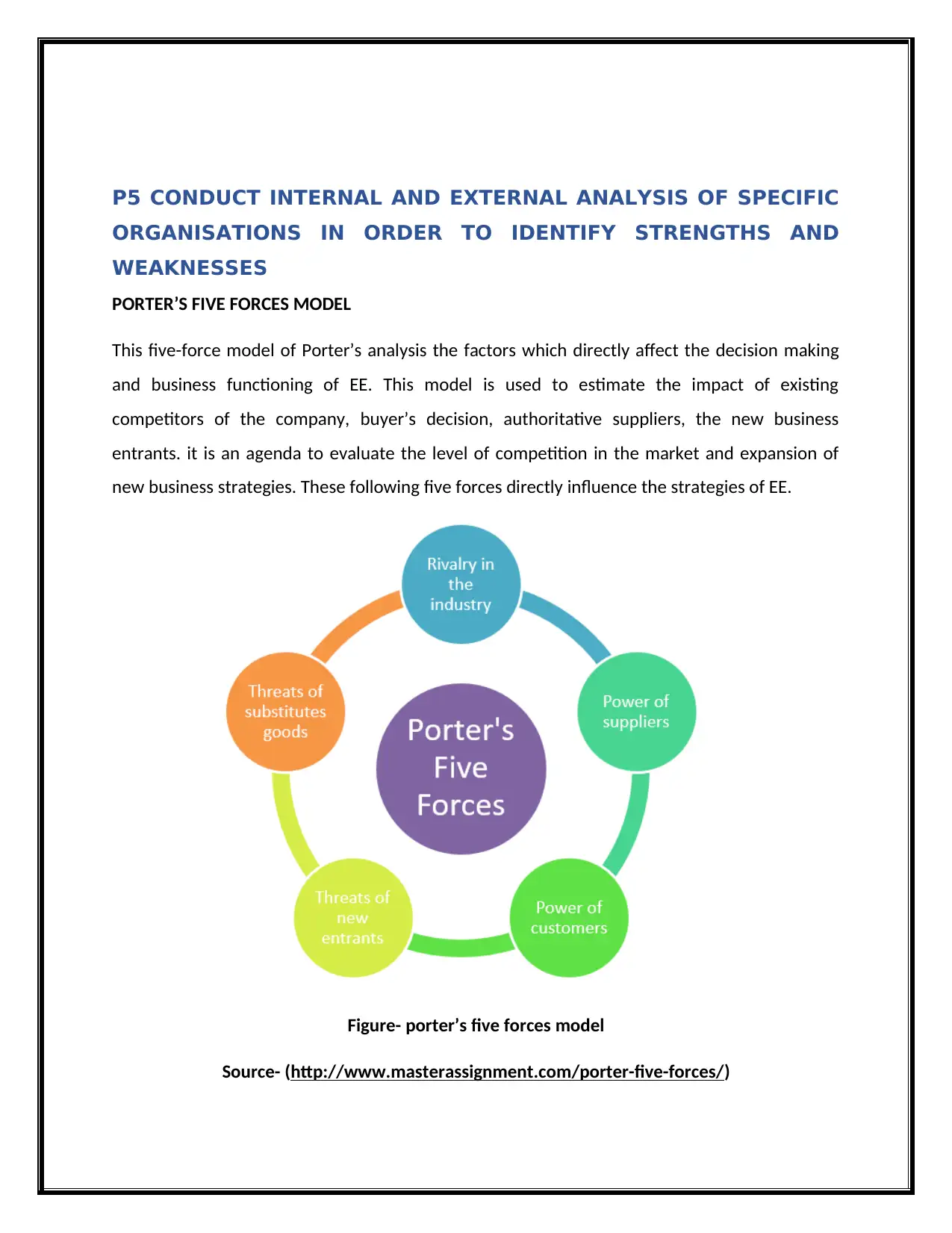
P5 CONDUCT INTERNAL AND EXTERNAL ANALYSIS OF SPECIFIC
ORGANISATIONS IN ORDER TO IDENTIFY STRENGTHS AND
WEAKNESSES
PORTER’S FIVE FORCES MODEL
This five-force model of Porter’s analysis the factors which directly affect the decision making
and business functioning of EE. This model is used to estimate the impact of existing
competitors of the company, buyer’s decision, authoritative suppliers, the new business
entrants. it is an agenda to evaluate the level of competition in the market and expansion of
new business strategies. These following five forces directly influence the strategies of EE.
Figure- porter’s five forces model
Source- (http://www.masterassignment.com/porter-five-forces/)
ORGANISATIONS IN ORDER TO IDENTIFY STRENGTHS AND
WEAKNESSES
PORTER’S FIVE FORCES MODEL
This five-force model of Porter’s analysis the factors which directly affect the decision making
and business functioning of EE. This model is used to estimate the impact of existing
competitors of the company, buyer’s decision, authoritative suppliers, the new business
entrants. it is an agenda to evaluate the level of competition in the market and expansion of
new business strategies. These following five forces directly influence the strategies of EE.
Figure- porter’s five forces model
Source- (http://www.masterassignment.com/porter-five-forces/)
Paraphrase This Document
Need a fresh take? Get an instant paraphrase of this document with our AI Paraphraser
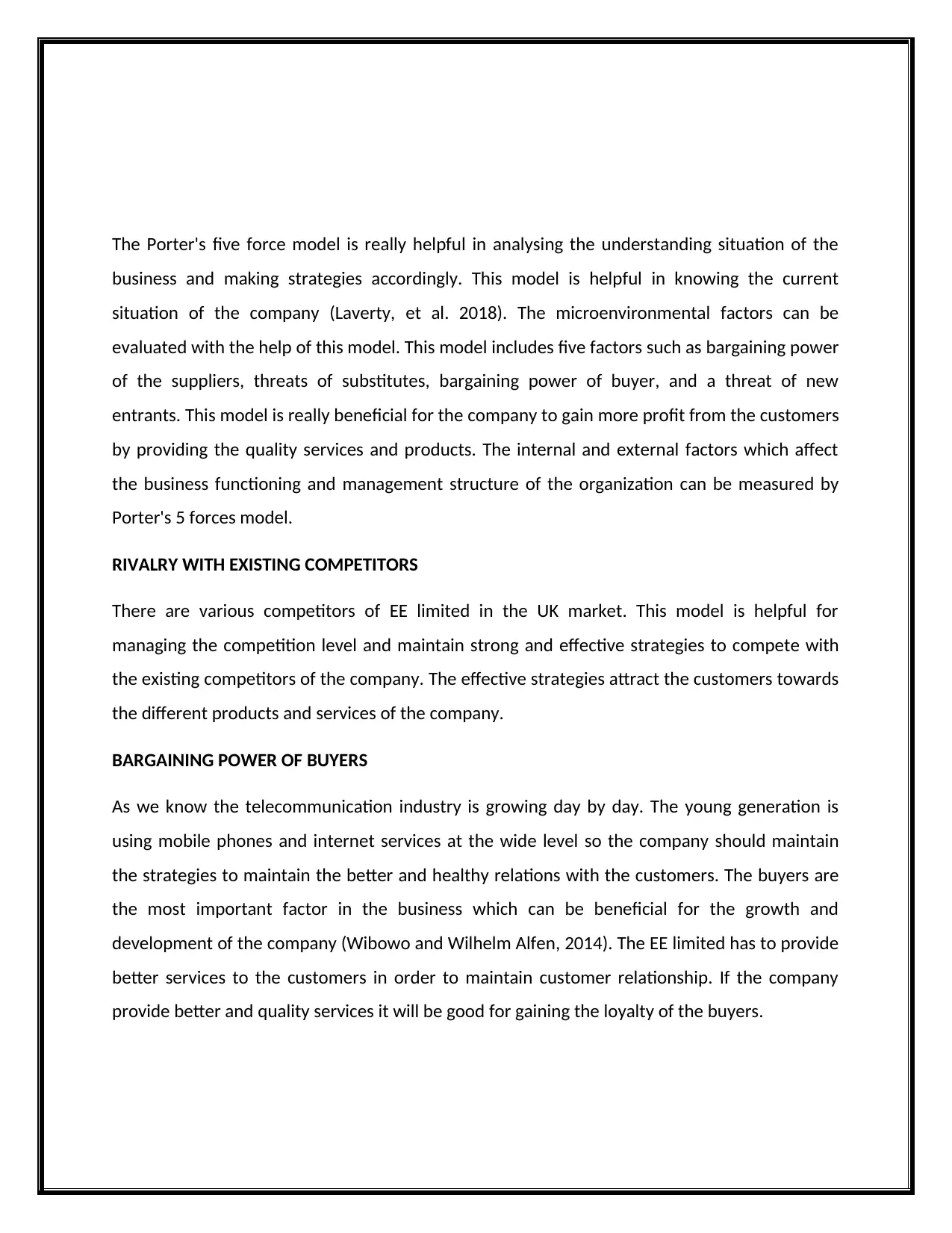
The Porter's five force model is really helpful in analysing the understanding situation of the
business and making strategies accordingly. This model is helpful in knowing the current
situation of the company (Laverty, et al. 2018). The microenvironmental factors can be
evaluated with the help of this model. This model includes five factors such as bargaining power
of the suppliers, threats of substitutes, bargaining power of buyer, and a threat of new
entrants. This model is really beneficial for the company to gain more profit from the customers
by providing the quality services and products. The internal and external factors which affect
the business functioning and management structure of the organization can be measured by
Porter's 5 forces model.
RIVALRY WITH EXISTING COMPETITORS
There are various competitors of EE limited in the UK market. This model is helpful for
managing the competition level and maintain strong and effective strategies to compete with
the existing competitors of the company. The effective strategies attract the customers towards
the different products and services of the company.
BARGAINING POWER OF BUYERS
As we know the telecommunication industry is growing day by day. The young generation is
using mobile phones and internet services at the wide level so the company should maintain
the strategies to maintain the better and healthy relations with the customers. The buyers are
the most important factor in the business which can be beneficial for the growth and
development of the company (Wibowo and Wilhelm Alfen, 2014). The EE limited has to provide
better services to the customers in order to maintain customer relationship. If the company
provide better and quality services it will be good for gaining the loyalty of the buyers.
business and making strategies accordingly. This model is helpful in knowing the current
situation of the company (Laverty, et al. 2018). The microenvironmental factors can be
evaluated with the help of this model. This model includes five factors such as bargaining power
of the suppliers, threats of substitutes, bargaining power of buyer, and a threat of new
entrants. This model is really beneficial for the company to gain more profit from the customers
by providing the quality services and products. The internal and external factors which affect
the business functioning and management structure of the organization can be measured by
Porter's 5 forces model.
RIVALRY WITH EXISTING COMPETITORS
There are various competitors of EE limited in the UK market. This model is helpful for
managing the competition level and maintain strong and effective strategies to compete with
the existing competitors of the company. The effective strategies attract the customers towards
the different products and services of the company.
BARGAINING POWER OF BUYERS
As we know the telecommunication industry is growing day by day. The young generation is
using mobile phones and internet services at the wide level so the company should maintain
the strategies to maintain the better and healthy relations with the customers. The buyers are
the most important factor in the business which can be beneficial for the growth and
development of the company (Wibowo and Wilhelm Alfen, 2014). The EE limited has to provide
better services to the customers in order to maintain customer relationship. If the company
provide better and quality services it will be good for gaining the loyalty of the buyers.
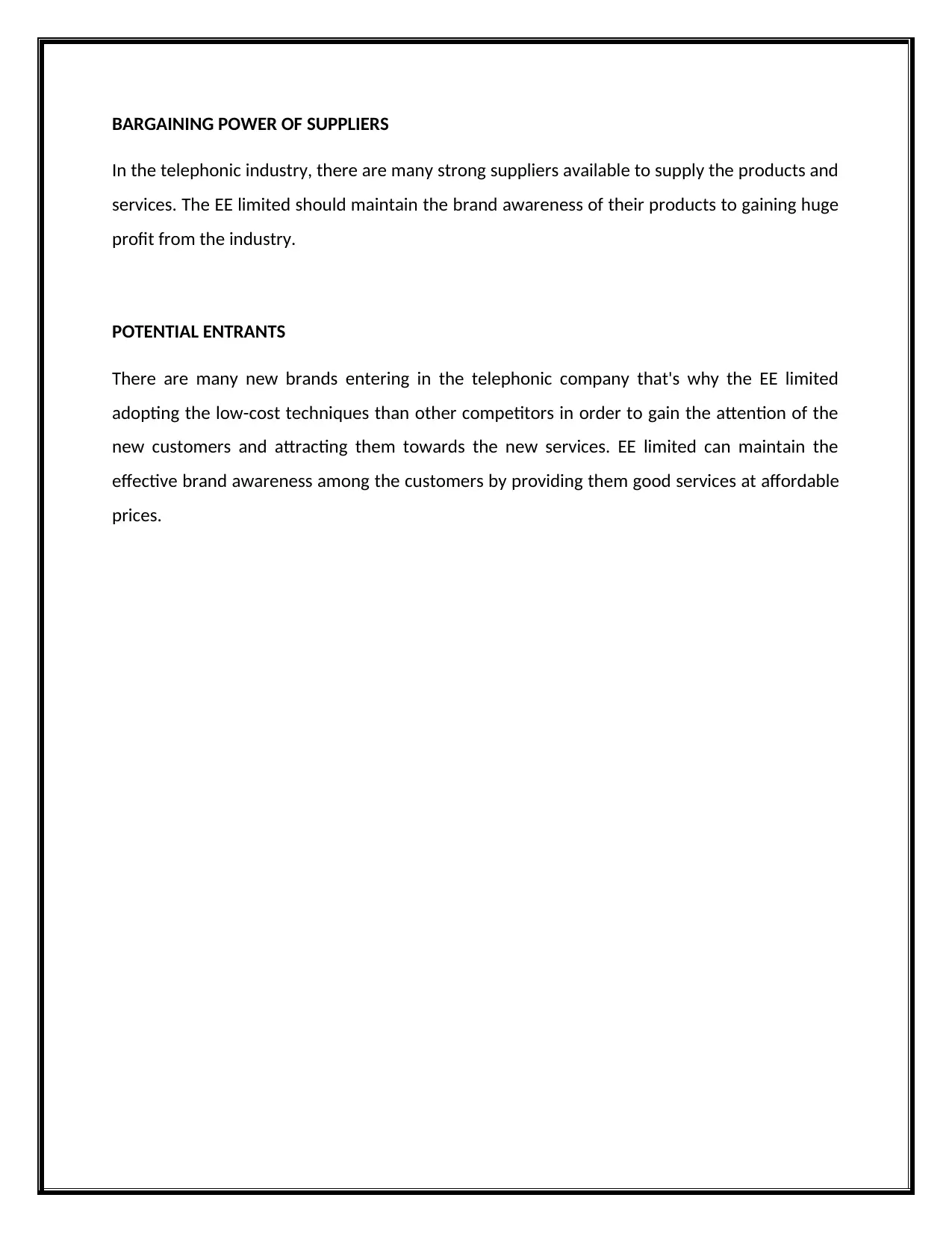
BARGAINING POWER OF SUPPLIERS
In the telephonic industry, there are many strong suppliers available to supply the products and
services. The EE limited should maintain the brand awareness of their products to gaining huge
profit from the industry.
POTENTIAL ENTRANTS
There are many new brands entering in the telephonic company that's why the EE limited
adopting the low-cost techniques than other competitors in order to gain the attention of the
new customers and attracting them towards the new services. EE limited can maintain the
effective brand awareness among the customers by providing them good services at affordable
prices.
In the telephonic industry, there are many strong suppliers available to supply the products and
services. The EE limited should maintain the brand awareness of their products to gaining huge
profit from the industry.
POTENTIAL ENTRANTS
There are many new brands entering in the telephonic company that's why the EE limited
adopting the low-cost techniques than other competitors in order to gain the attention of the
new customers and attracting them towards the new services. EE limited can maintain the
effective brand awareness among the customers by providing them good services at affordable
prices.
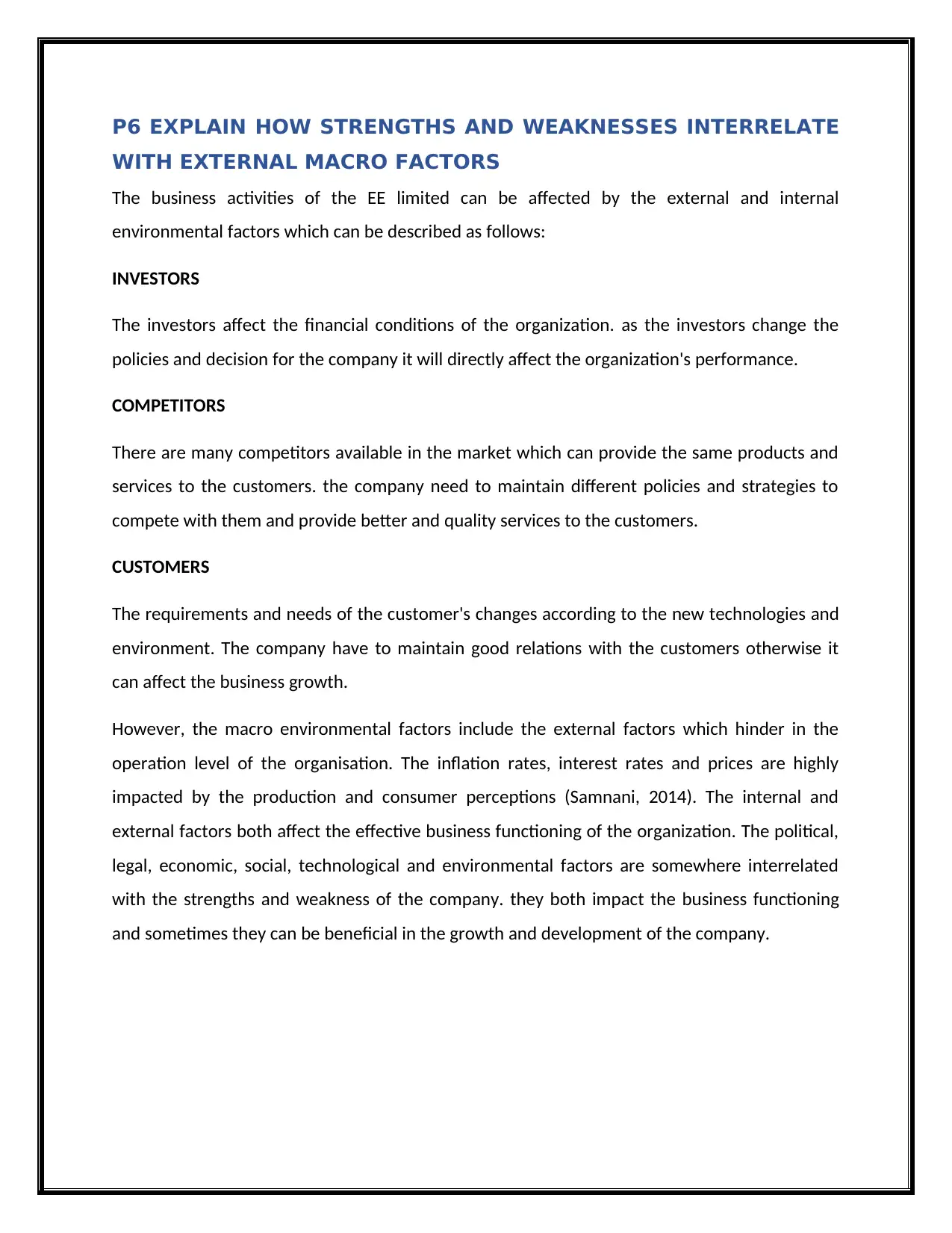
P6 EXPLAIN HOW STRENGTHS AND WEAKNESSES INTERRELATE
WITH EXTERNAL MACRO FACTORS
The business activities of the EE limited can be affected by the external and internal
environmental factors which can be described as follows:
INVESTORS
The investors affect the financial conditions of the organization. as the investors change the
policies and decision for the company it will directly affect the organization's performance.
COMPETITORS
There are many competitors available in the market which can provide the same products and
services to the customers. the company need to maintain different policies and strategies to
compete with them and provide better and quality services to the customers.
CUSTOMERS
The requirements and needs of the customer's changes according to the new technologies and
environment. The company have to maintain good relations with the customers otherwise it
can affect the business growth.
However, the macro environmental factors include the external factors which hinder in the
operation level of the organisation. The inflation rates, interest rates and prices are highly
impacted by the production and consumer perceptions (Samnani, 2014). The internal and
external factors both affect the effective business functioning of the organization. The political,
legal, economic, social, technological and environmental factors are somewhere interrelated
with the strengths and weakness of the company. they both impact the business functioning
and sometimes they can be beneficial in the growth and development of the company.
WITH EXTERNAL MACRO FACTORS
The business activities of the EE limited can be affected by the external and internal
environmental factors which can be described as follows:
INVESTORS
The investors affect the financial conditions of the organization. as the investors change the
policies and decision for the company it will directly affect the organization's performance.
COMPETITORS
There are many competitors available in the market which can provide the same products and
services to the customers. the company need to maintain different policies and strategies to
compete with them and provide better and quality services to the customers.
CUSTOMERS
The requirements and needs of the customer's changes according to the new technologies and
environment. The company have to maintain good relations with the customers otherwise it
can affect the business growth.
However, the macro environmental factors include the external factors which hinder in the
operation level of the organisation. The inflation rates, interest rates and prices are highly
impacted by the production and consumer perceptions (Samnani, 2014). The internal and
external factors both affect the effective business functioning of the organization. The political,
legal, economic, social, technological and environmental factors are somewhere interrelated
with the strengths and weakness of the company. they both impact the business functioning
and sometimes they can be beneficial in the growth and development of the company.
Secure Best Marks with AI Grader
Need help grading? Try our AI Grader for instant feedback on your assignments.
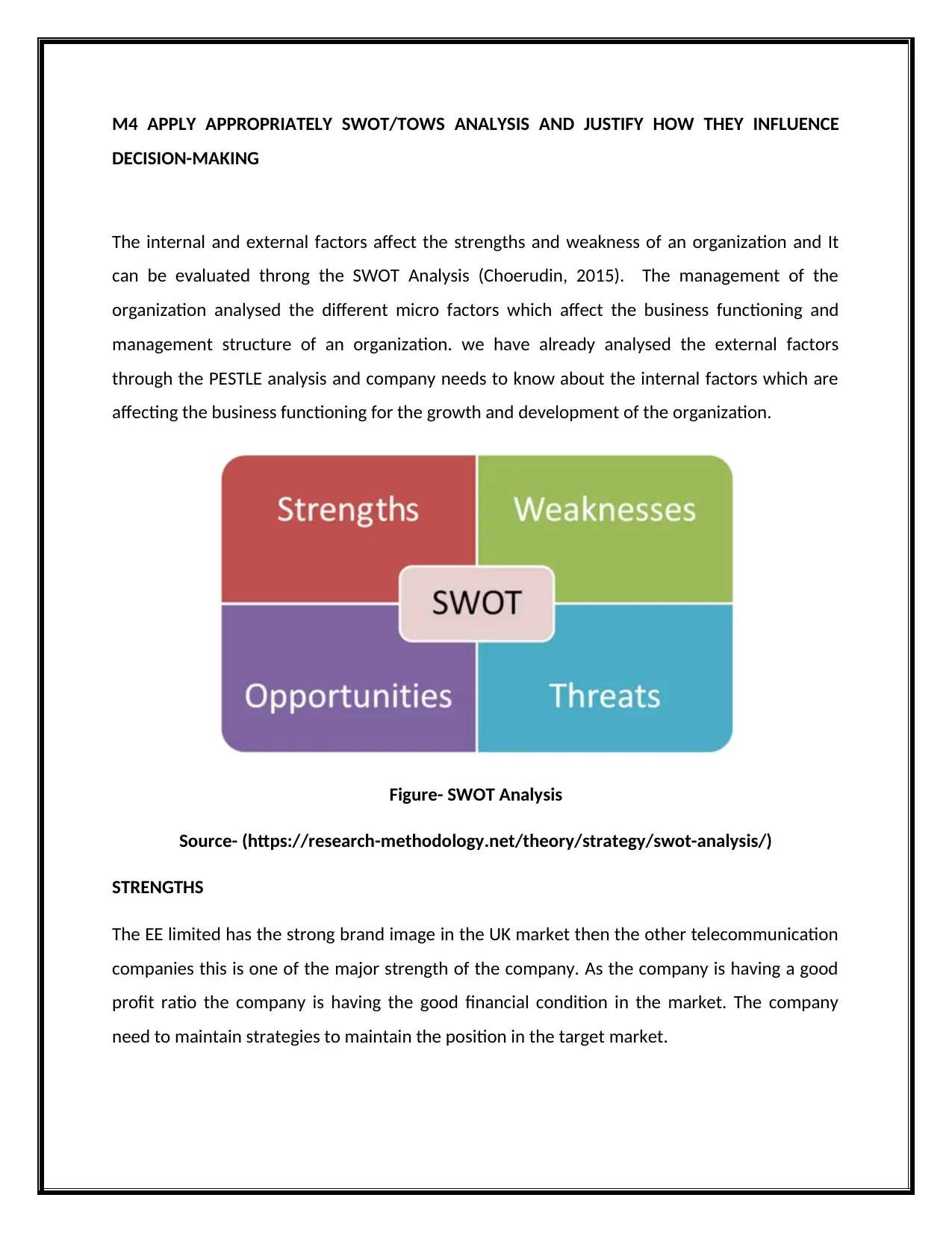
M4 APPLY APPROPRIATELY SWOT/TOWS ANALYSIS AND JUSTIFY HOW THEY INFLUENCE
DECISION-MAKING
The internal and external factors affect the strengths and weakness of an organization and It
can be evaluated throng the SWOT Analysis (Choerudin, 2015). The management of the
organization analysed the different micro factors which affect the business functioning and
management structure of an organization. we have already analysed the external factors
through the PESTLE analysis and company needs to know about the internal factors which are
affecting the business functioning for the growth and development of the organization.
Figure- SWOT Analysis
Source- (https://research-methodology.net/theory/strategy/swot-analysis/)
STRENGTHS
The EE limited has the strong brand image in the UK market then the other telecommunication
companies this is one of the major strength of the company. As the company is having a good
profit ratio the company is having the good financial condition in the market. The company
need to maintain strategies to maintain the position in the target market.
DECISION-MAKING
The internal and external factors affect the strengths and weakness of an organization and It
can be evaluated throng the SWOT Analysis (Choerudin, 2015). The management of the
organization analysed the different micro factors which affect the business functioning and
management structure of an organization. we have already analysed the external factors
through the PESTLE analysis and company needs to know about the internal factors which are
affecting the business functioning for the growth and development of the organization.
Figure- SWOT Analysis
Source- (https://research-methodology.net/theory/strategy/swot-analysis/)
STRENGTHS
The EE limited has the strong brand image in the UK market then the other telecommunication
companies this is one of the major strength of the company. As the company is having a good
profit ratio the company is having the good financial condition in the market. The company
need to maintain strategies to maintain the position in the target market.
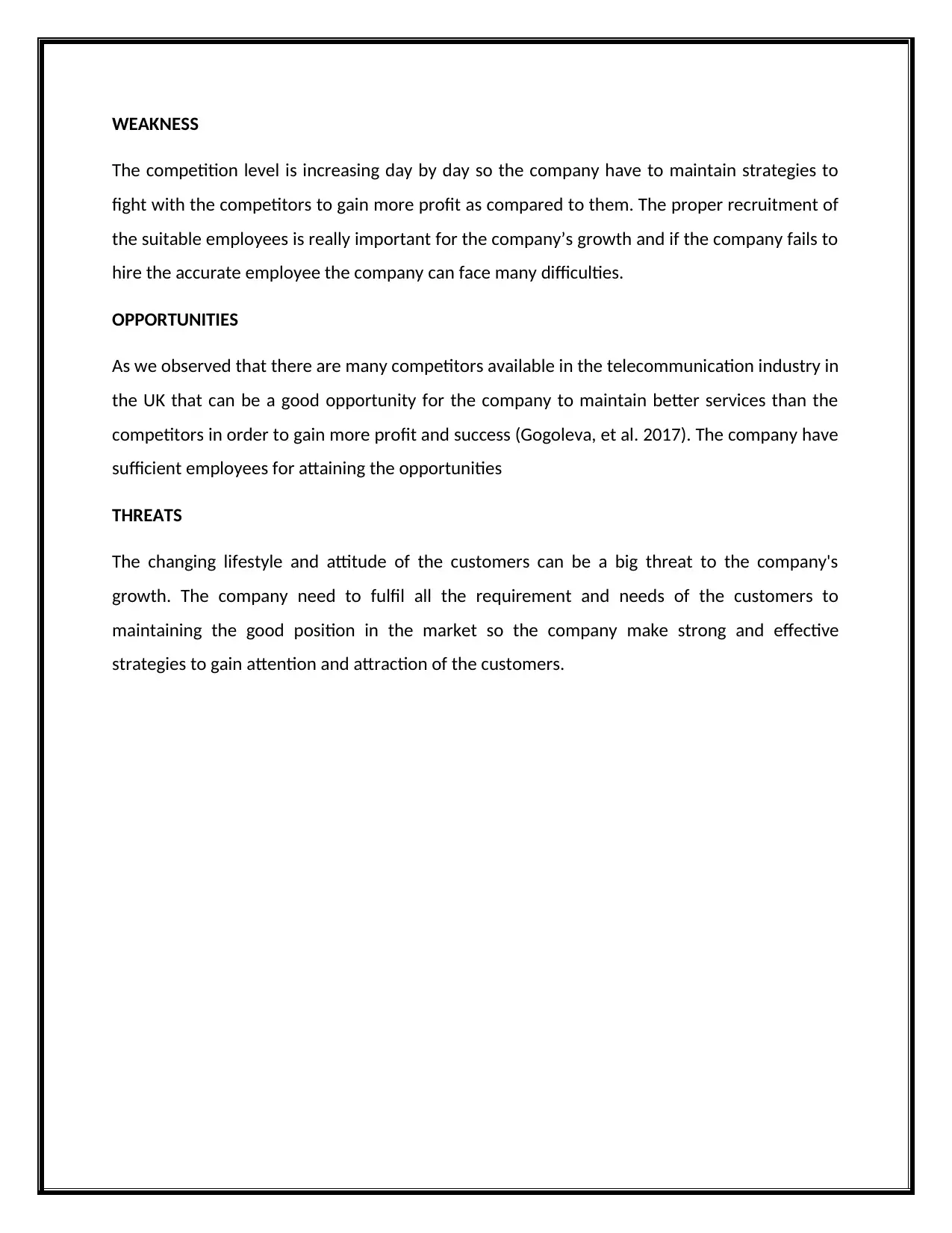
WEAKNESS
The competition level is increasing day by day so the company have to maintain strategies to
fight with the competitors to gain more profit as compared to them. The proper recruitment of
the suitable employees is really important for the company’s growth and if the company fails to
hire the accurate employee the company can face many difficulties.
OPPORTUNITIES
As we observed that there are many competitors available in the telecommunication industry in
the UK that can be a good opportunity for the company to maintain better services than the
competitors in order to gain more profit and success (Gogoleva, et al. 2017). The company have
sufficient employees for attaining the opportunities
THREATS
The changing lifestyle and attitude of the customers can be a big threat to the company's
growth. The company need to fulfil all the requirement and needs of the customers to
maintaining the good position in the market so the company make strong and effective
strategies to gain attention and attraction of the customers.
The competition level is increasing day by day so the company have to maintain strategies to
fight with the competitors to gain more profit as compared to them. The proper recruitment of
the suitable employees is really important for the company’s growth and if the company fails to
hire the accurate employee the company can face many difficulties.
OPPORTUNITIES
As we observed that there are many competitors available in the telecommunication industry in
the UK that can be a good opportunity for the company to maintain better services than the
competitors in order to gain more profit and success (Gogoleva, et al. 2017). The company have
sufficient employees for attaining the opportunities
THREATS
The changing lifestyle and attitude of the customers can be a big threat to the company's
growth. The company need to fulfil all the requirement and needs of the customers to
maintaining the good position in the market so the company make strong and effective
strategies to gain attention and attraction of the customers.
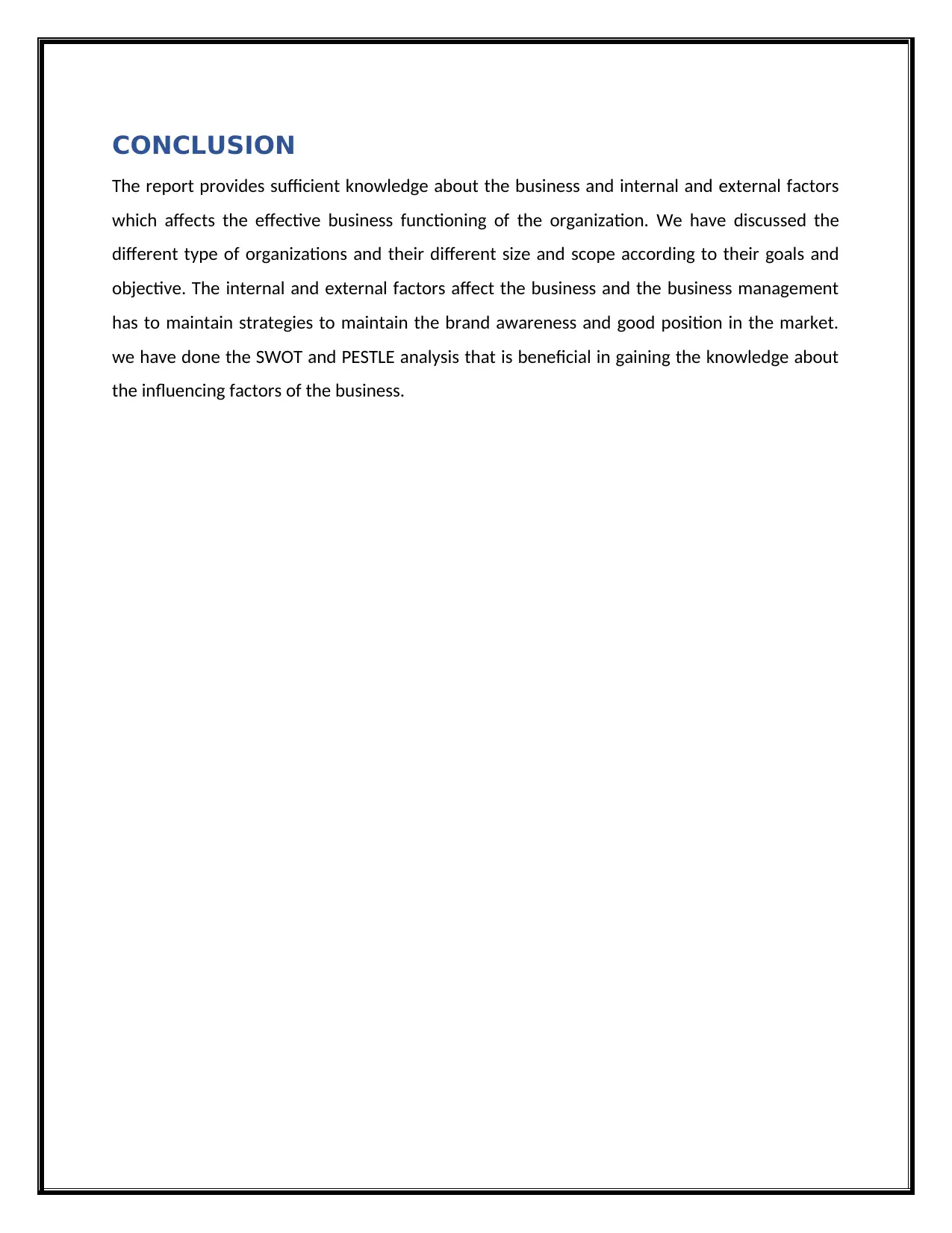
CONCLUSION
The report provides sufficient knowledge about the business and internal and external factors
which affects the effective business functioning of the organization. We have discussed the
different type of organizations and their different size and scope according to their goals and
objective. The internal and external factors affect the business and the business management
has to maintain strategies to maintain the brand awareness and good position in the market.
we have done the SWOT and PESTLE analysis that is beneficial in gaining the knowledge about
the influencing factors of the business.
The report provides sufficient knowledge about the business and internal and external factors
which affects the effective business functioning of the organization. We have discussed the
different type of organizations and their different size and scope according to their goals and
objective. The internal and external factors affect the business and the business management
has to maintain strategies to maintain the brand awareness and good position in the market.
we have done the SWOT and PESTLE analysis that is beneficial in gaining the knowledge about
the influencing factors of the business.
Paraphrase This Document
Need a fresh take? Get an instant paraphrase of this document with our AI Paraphraser
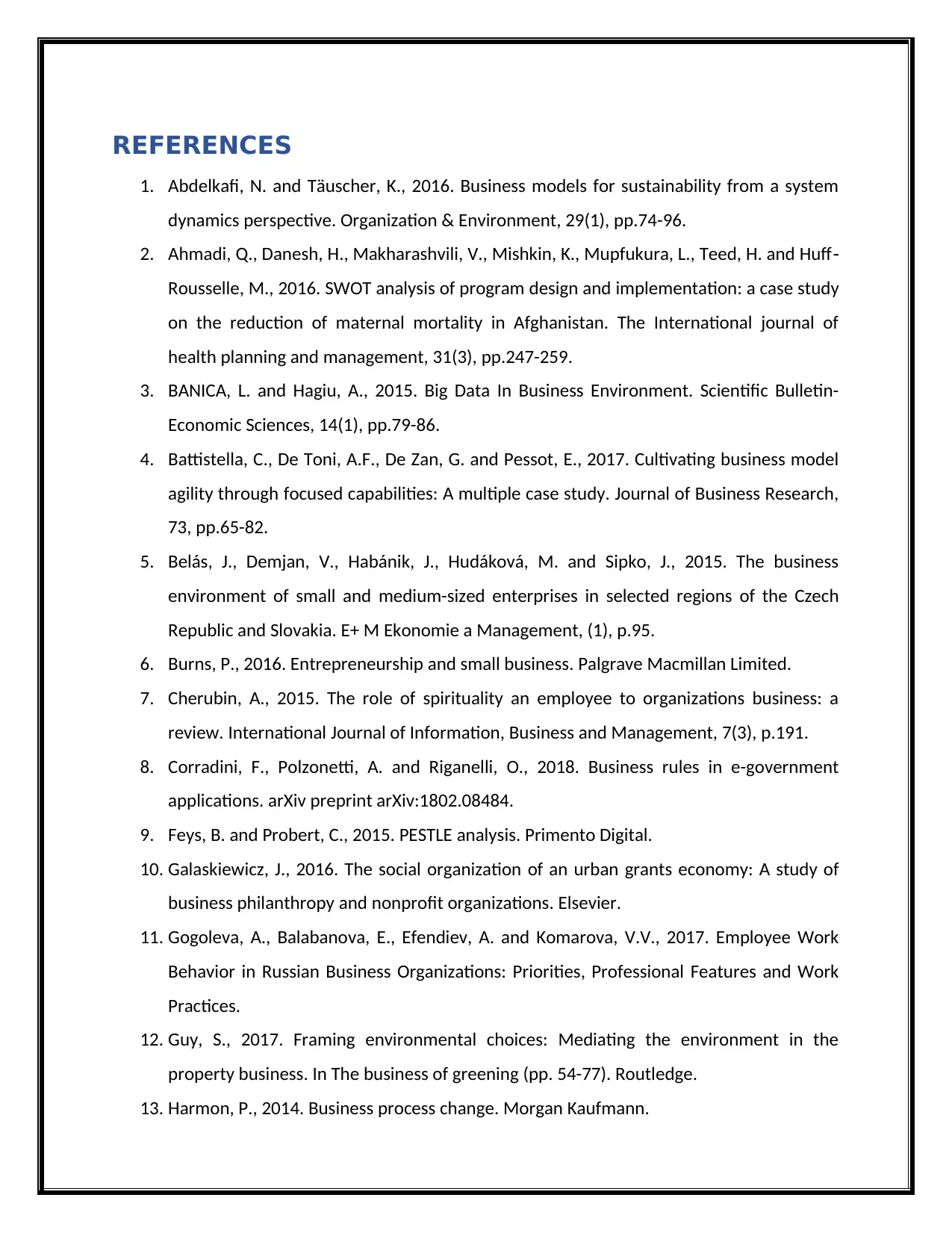
REFERENCES
1. Abdelkafi, N. and Täuscher, K., 2016. Business models for sustainability from a system
dynamics perspective. Organization & Environment, 29(1), pp.74-96.
2. Ahmadi, Q., Danesh, H., Makharashvili, V., Mishkin, K., Mupfukura, L., Teed, H. and Huff‐
Rousselle, M., 2016. SWOT analysis of program design and implementation: a case study
on the reduction of maternal mortality in Afghanistan. The International journal of
health planning and management, 31(3), pp.247-259.
3. BANICA, L. and Hagiu, A., 2015. Big Data In Business Environment. Scientific Bulletin-
Economic Sciences, 14(1), pp.79-86.
4. Battistella, C., De Toni, A.F., De Zan, G. and Pessot, E., 2017. Cultivating business model
agility through focused capabilities: A multiple case study. Journal of Business Research,
73, pp.65-82.
5. Belás, J., Demjan, V., Habánik, J., Hudáková, M. and Sipko, J., 2015. The business
environment of small and medium-sized enterprises in selected regions of the Czech
Republic and Slovakia. E+ M Ekonomie a Management, (1), p.95.
6. Burns, P., 2016. Entrepreneurship and small business. Palgrave Macmillan Limited.
7. Cherubin, A., 2015. The role of spirituality an employee to organizations business: a
review. International Journal of Information, Business and Management, 7(3), p.191.
8. Corradini, F., Polzonetti, A. and Riganelli, O., 2018. Business rules in e-government
applications. arXiv preprint arXiv:1802.08484.
9. Feys, B. and Probert, C., 2015. PESTLE analysis. Primento Digital.
10. Galaskiewicz, J., 2016. The social organization of an urban grants economy: A study of
business philanthropy and nonprofit organizations. Elsevier.
11. Gogoleva, A., Balabanova, E., Efendiev, A. and Komarova, V.V., 2017. Employee Work
Behavior in Russian Business Organizations: Priorities, Professional Features and Work
Practices.
12. Guy, S., 2017. Framing environmental choices: Mediating the environment in the
property business. In The business of greening (pp. 54-77). Routledge.
13. Harmon, P., 2014. Business process change. Morgan Kaufmann.
1. Abdelkafi, N. and Täuscher, K., 2016. Business models for sustainability from a system
dynamics perspective. Organization & Environment, 29(1), pp.74-96.
2. Ahmadi, Q., Danesh, H., Makharashvili, V., Mishkin, K., Mupfukura, L., Teed, H. and Huff‐
Rousselle, M., 2016. SWOT analysis of program design and implementation: a case study
on the reduction of maternal mortality in Afghanistan. The International journal of
health planning and management, 31(3), pp.247-259.
3. BANICA, L. and Hagiu, A., 2015. Big Data In Business Environment. Scientific Bulletin-
Economic Sciences, 14(1), pp.79-86.
4. Battistella, C., De Toni, A.F., De Zan, G. and Pessot, E., 2017. Cultivating business model
agility through focused capabilities: A multiple case study. Journal of Business Research,
73, pp.65-82.
5. Belás, J., Demjan, V., Habánik, J., Hudáková, M. and Sipko, J., 2015. The business
environment of small and medium-sized enterprises in selected regions of the Czech
Republic and Slovakia. E+ M Ekonomie a Management, (1), p.95.
6. Burns, P., 2016. Entrepreneurship and small business. Palgrave Macmillan Limited.
7. Cherubin, A., 2015. The role of spirituality an employee to organizations business: a
review. International Journal of Information, Business and Management, 7(3), p.191.
8. Corradini, F., Polzonetti, A. and Riganelli, O., 2018. Business rules in e-government
applications. arXiv preprint arXiv:1802.08484.
9. Feys, B. and Probert, C., 2015. PESTLE analysis. Primento Digital.
10. Galaskiewicz, J., 2016. The social organization of an urban grants economy: A study of
business philanthropy and nonprofit organizations. Elsevier.
11. Gogoleva, A., Balabanova, E., Efendiev, A. and Komarova, V.V., 2017. Employee Work
Behavior in Russian Business Organizations: Priorities, Professional Features and Work
Practices.
12. Guy, S., 2017. Framing environmental choices: Mediating the environment in the
property business. In The business of greening (pp. 54-77). Routledge.
13. Harmon, P., 2014. Business process change. Morgan Kaufmann.
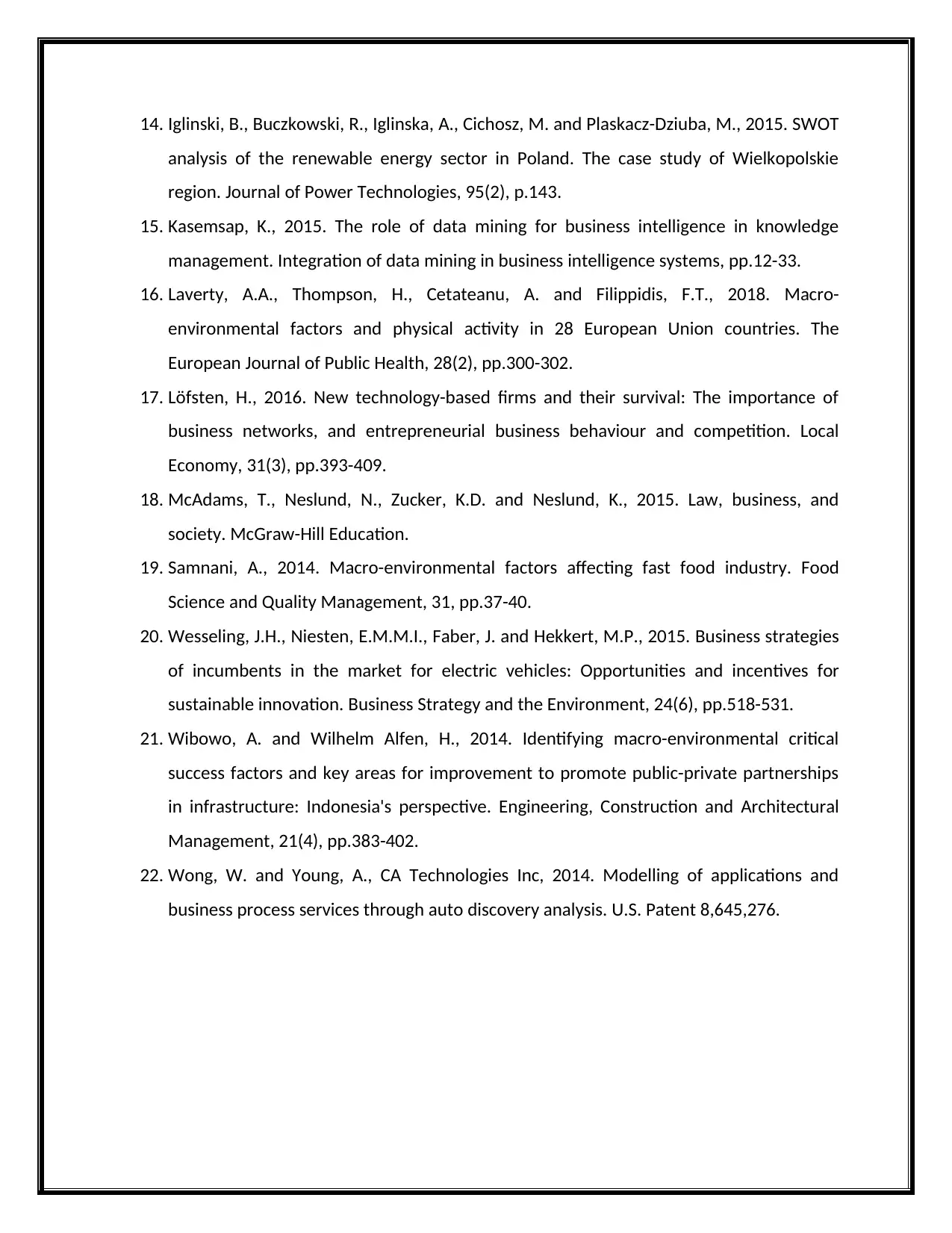
14. Iglinski, B., Buczkowski, R., Iglinska, A., Cichosz, M. and Plaskacz-Dziuba, M., 2015. SWOT
analysis of the renewable energy sector in Poland. The case study of Wielkopolskie
region. Journal of Power Technologies, 95(2), p.143.
15. Kasemsap, K., 2015. The role of data mining for business intelligence in knowledge
management. Integration of data mining in business intelligence systems, pp.12-33.
16. Laverty, A.A., Thompson, H., Cetateanu, A. and Filippidis, F.T., 2018. Macro-
environmental factors and physical activity in 28 European Union countries. The
European Journal of Public Health, 28(2), pp.300-302.
17. Löfsten, H., 2016. New technology-based firms and their survival: The importance of
business networks, and entrepreneurial business behaviour and competition. Local
Economy, 31(3), pp.393-409.
18. McAdams, T., Neslund, N., Zucker, K.D. and Neslund, K., 2015. Law, business, and
society. McGraw-Hill Education.
19. Samnani, A., 2014. Macro-environmental factors affecting fast food industry. Food
Science and Quality Management, 31, pp.37-40.
20. Wesseling, J.H., Niesten, E.M.M.I., Faber, J. and Hekkert, M.P., 2015. Business strategies
of incumbents in the market for electric vehicles: Opportunities and incentives for
sustainable innovation. Business Strategy and the Environment, 24(6), pp.518-531.
21. Wibowo, A. and Wilhelm Alfen, H., 2014. Identifying macro-environmental critical
success factors and key areas for improvement to promote public-private partnerships
in infrastructure: Indonesia's perspective. Engineering, Construction and Architectural
Management, 21(4), pp.383-402.
22. Wong, W. and Young, A., CA Technologies Inc, 2014. Modelling of applications and
business process services through auto discovery analysis. U.S. Patent 8,645,276.
analysis of the renewable energy sector in Poland. The case study of Wielkopolskie
region. Journal of Power Technologies, 95(2), p.143.
15. Kasemsap, K., 2015. The role of data mining for business intelligence in knowledge
management. Integration of data mining in business intelligence systems, pp.12-33.
16. Laverty, A.A., Thompson, H., Cetateanu, A. and Filippidis, F.T., 2018. Macro-
environmental factors and physical activity in 28 European Union countries. The
European Journal of Public Health, 28(2), pp.300-302.
17. Löfsten, H., 2016. New technology-based firms and their survival: The importance of
business networks, and entrepreneurial business behaviour and competition. Local
Economy, 31(3), pp.393-409.
18. McAdams, T., Neslund, N., Zucker, K.D. and Neslund, K., 2015. Law, business, and
society. McGraw-Hill Education.
19. Samnani, A., 2014. Macro-environmental factors affecting fast food industry. Food
Science and Quality Management, 31, pp.37-40.
20. Wesseling, J.H., Niesten, E.M.M.I., Faber, J. and Hekkert, M.P., 2015. Business strategies
of incumbents in the market for electric vehicles: Opportunities and incentives for
sustainable innovation. Business Strategy and the Environment, 24(6), pp.518-531.
21. Wibowo, A. and Wilhelm Alfen, H., 2014. Identifying macro-environmental critical
success factors and key areas for improvement to promote public-private partnerships
in infrastructure: Indonesia's perspective. Engineering, Construction and Architectural
Management, 21(4), pp.383-402.
22. Wong, W. and Young, A., CA Technologies Inc, 2014. Modelling of applications and
business process services through auto discovery analysis. U.S. Patent 8,645,276.
1 out of 27
Related Documents
Your All-in-One AI-Powered Toolkit for Academic Success.
+13062052269
info@desklib.com
Available 24*7 on WhatsApp / Email
![[object Object]](/_next/static/media/star-bottom.7253800d.svg)
Unlock your academic potential
© 2024 | Zucol Services PVT LTD | All rights reserved.





